2020 People of Color in Tech Report
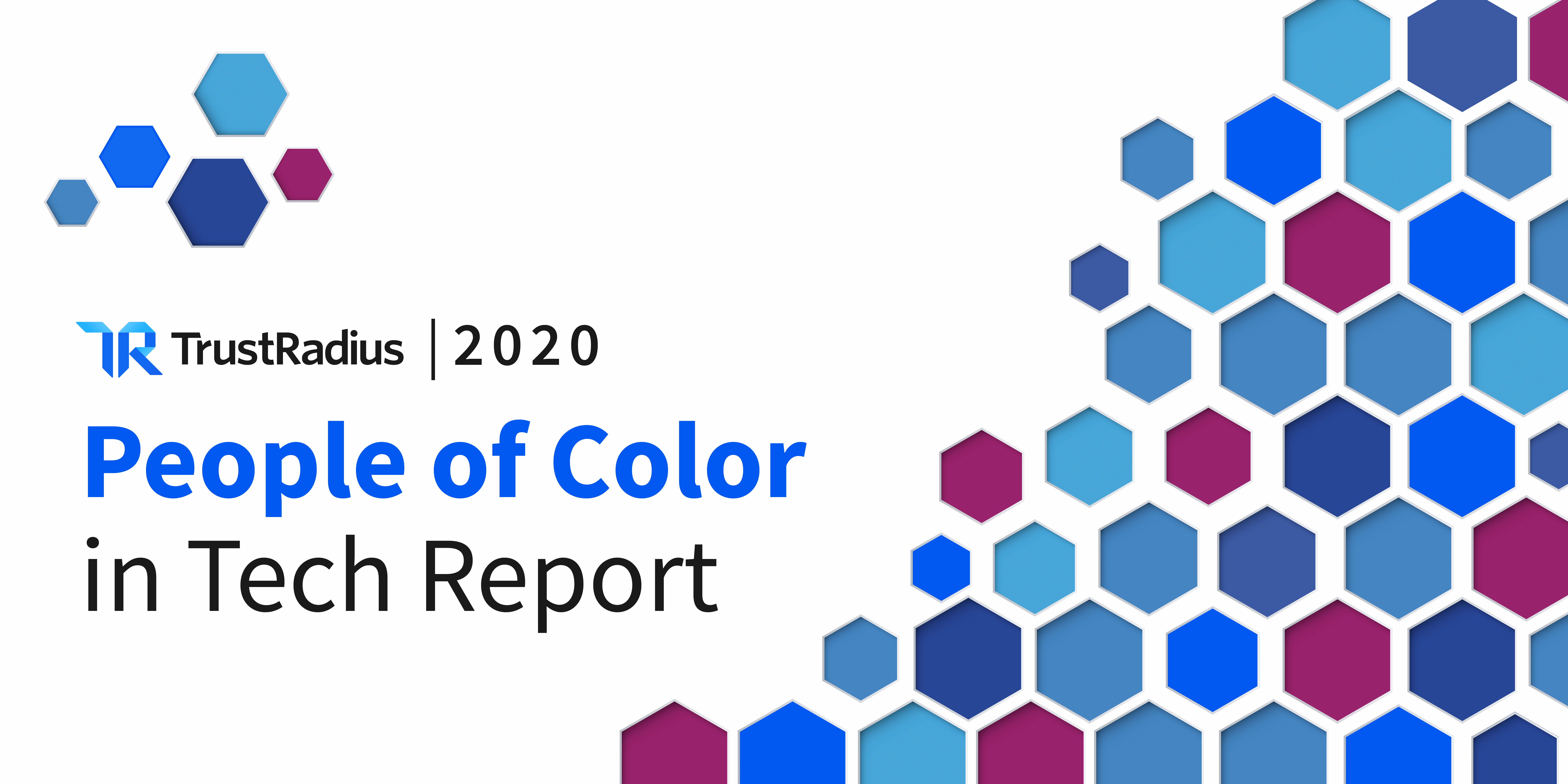
The People of Color in Tech Report is the first of its kind for TrustRadius. As a company dedicated to transparency and integrity, we wanted to highlight the experiences of marginalized groups in the tech industry. Earlier this year we published our second annual Women in Tech Report, which took an intersectional view, but this is our first full study focused on the experiences of POC in our industry.
Global conversations around racial inequality have spiked in interest this year due to the extrajudicial murder of George Floyd in the U.S. Now, companies can no longer ignore how the inequalities in their very own industries contribute to the marginalization of certain populations outside of their businesses. It is our hope that this report aids tech leaders, enabling their organizations to become centers of innovation driven by true inclusivity.
Topics in the report explore the tech industry’s attitude towards racial discrimination and making progress towards equality, including:
This report also features exclusive interviews with 10 POC tech leaders and professionals. These profiles explore how each individual got started and how they’re working towards making the tech industry a more equitable place.
Click here for a printable PDF version of the report.
Methodology
The TrustRadius People of Color in Tech Report survey was open to everyone who works in the tech industry regardless of race or ethnicity. TrustRadius invited its global audience and their networks to take part via email and social outreach. 1,207 professionals in the tech industry took our survey. All responses were anonymous to assure privacy and allow respondents to share their honest answers. TrustRadius offered a nominal incentive to thank respondents for their time ($50 donation to nonprofit organization Code2College for the first 100 responses, for a $5,000 total donation). 53% of our respondents identified as people of color. You can find detailed demographic information on survey respondents here.
A Word From Vinay Bhagat
TrustRadius Founder and CEO
 The George Floyd killing and the subsequent protests served as a wake-up call for me about racial inequity in our country. It felt like I and other corporate leaders were being called to action and could no longer remain silent. Scores of companies issued messages of support for Black Lives Matter. Some committed to address issues of representation inside their own companies.
The George Floyd killing and the subsequent protests served as a wake-up call for me about racial inequity in our country. It felt like I and other corporate leaders were being called to action and could no longer remain silent. Scores of companies issued messages of support for Black Lives Matter. Some committed to address issues of representation inside their own companies.
This report is deeply personal to me. I’m a first-generation immigrant, and a person of color (of Indian descent). I am, however, privileged. I haven’t faced the barriers Black and Latine people experience in the U.S. However, growing up in the UK, I was subjected to daily verbal and physical abuse because of my race. I also experienced microaggressions—commonly, the presumption that I couldn’t speak English properly. I also faced career barriers.
Graduating from Cambridge, I couldn’t even get a first-round interview with the top 3 management consulting firms (McKinsey, BCG, Bain), despite finishing in the top 5% of my class. I attended Stanford University on a scholarship, where I was asked by the same firms to apply in the US. I joined Bain in San Francisco but was rejected by their London office for a second time. I transferred to the London office, shared my story, and was told that it must have been a clerical error. Seeing that I was the only person of color in a team of ~100 aside from the telecom manager, I knew that it wasn’t.
Per the Brookings Institute, just 6.8% of computing and math-related jobs are held by Black and Latine people today.
I asked to analyze their last 5 years of recruiting history, and demonstrated that they were recruiting people in their same mold—people who had attended elite private high schools, played the same sports, etc. To their credit, upon hearing my analysis, the company changed their recruiting practices and hired 3 people of color the next year.
I later came to the United States, as I saw it as a country where I could succeed solely based upon my talent and hard work. For me, that’s been the case. I’ve founded two companies that have created hundreds of jobs. But it’s not the case for many others. This report clearly demonstrates that tech companies need to do more to drive diversity. It also demonstrates that there is very real prejudice and unconscious bias that people of color face in the workplace. The US tech industry employs 12 million people and pays very well. Per the Brookings Institute, just 6.8% of computing and math-related jobs are held by Black and Latine people today.
As a CEO, recent events and this report have caused me to evaluate my own company. I know my house is not in order. The primary issue for TrustRadius to tackle is diversity. To accomplish that we need to ensure that we source from a diverse candidate pool, address unconscious bias, and ensure POC feel welcome. We’re starting by running a series of workshops on unconscious bias, most of which I’m personally facilitating. The workshops have been deeply personal and enlightening. They’ve highlighted the tendency for people to prefer candidates and coworkers similar to themselves.
As a CEO, recent events and this report have caused me to evaluate my own company. I know my house is not in order. The primary issue for TrustRadius to tackle is diversity.
Another issue we’re seeking to address is the candidate experience. Do potential hires meet with diverse people assuring them that our workplace will be welcoming? Increasing the diversity of our candidate pool remains a struggle. To help address this systemic issue, we’re volunteering with Code2College, a nonprofit that helps highschoolers from underrepresented backgrounds access the tech industry. So far more than 25% of my team is participating.
As the founder of a platform trusted by millions of technology professionals, I feel a duty to use our platform for good. For the last two years, we’ve reported on Women in Tech. This is our inaugural People of Color in Tech Report. Just like my journey to address diversity in my company, it’s a work in progress and we welcome your feedback.
I want to recognize Sam Huisache on our research team who has been the driving force behind this report and several of our own POC team members who have shared their life experiences below.
I want to thank all the survey participants, and also the tech leaders and professionals who took the time to share their stories with us. I hope that you find this report thought-provoking. More importantly, I hope it stimulates conversation and change.

The Faces of Tech
While income inequality is still one of the biggest obstacles for people of color, people of color in tech also face a particularly challenging reality: they are critically outnumbered, by an oppressive margin. According to a demographics analysis from Wired, Black, Latine, and Native tech professionals make up less than 5% of the workforce at major tech companies.
Industry-wide demographic surveys are relatively uncommon, which can make it difficult to precisely rate how the industry as a whole is performing in terms of diversity. This makes it even more important for tech leaders to perform demographics surveys of their individual workforces to determine who is representing their company.
According to a demographics analysis from Wired, Black, Latine, and Native tech professionals make up less than 5% of the workforce at major tech companies. Representation is a key component to attracting people of color to the tech industry, as well as ensuring an inclusive environment and retaining them as employees.
Representation is a key component to attracting people of color to the tech industry, as well as ensuring an inclusive environment and retaining them as employees. Seeing coworkers and peers with similar backgrounds to yours provides a sense of community. This can make an especially big difference for people of color in an otherwise predominantly white field. Seeing Black and brown faces in tech is important for attracting aspiring tech professionals of color and inspiring them to stay in the industry as they grow their careers.
Visibility
Representation of POC in the industry is low, but the numbers may be improving. A majority of our survey respondents reported that there are more POC in tech now compared to 10 years ago.
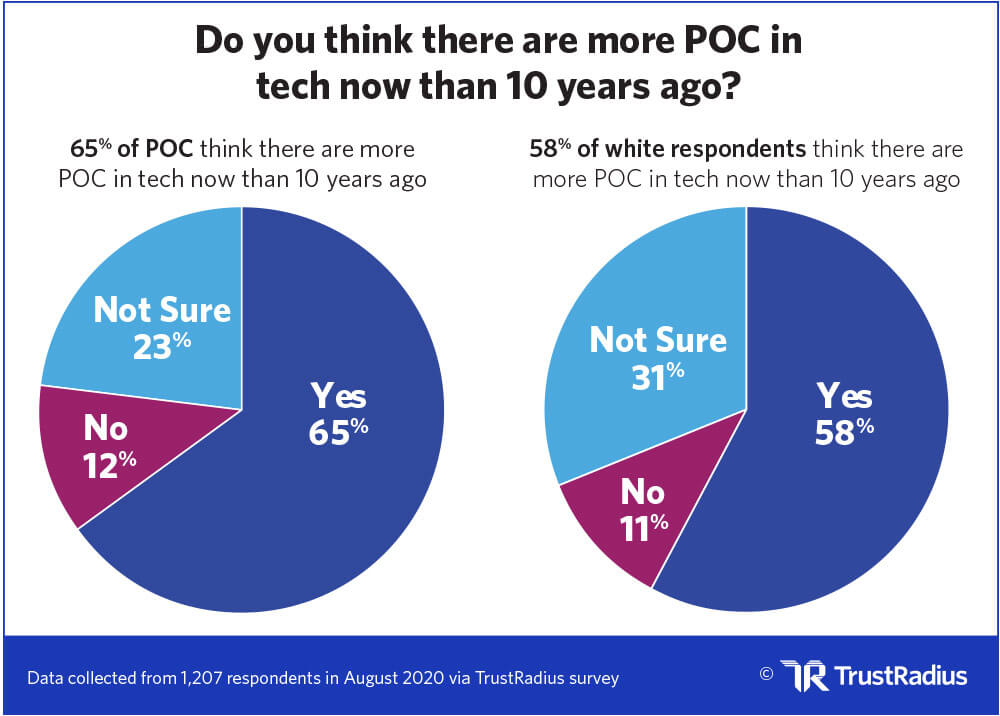
65% of POC in tech and 58% of their white peers see increased diversity over the past ten years. Their perceptions being so closely aligned may indicate that there has in fact been an improvement in overall numbers for people of color in the field.
The slight difference in perception may be due to POC being more mindful of their peers being present versus white employees. (This is also evidenced by a higher percentage of white respondents answering “Not sure” – 31% compared to 23% of POC respondents.)
While the tech industry seems to be improving upon including more POC, it may still not be moving at a fast enough pace to significantly combat racial inequality and achieve representation within its workforce. Camaraderie is an important aspect of surviving the tech industry as a person of color, and finding coworkers with similar experiences can be what makes navigating discrimination possible.
Are some cities growing diversity in tech at a faster rate?
There does seem to be some correlation between location and whether or not respondents report seeing more POC in tech over the years. In all cities, over half of respondents said “yes,” they do see more people of color in tech now compared to ten years ago. However, respondents in some cities were significantly more likely than others to see more people of color in tech.
Out of all the major cities we polled, respondents from Atlanta were the most likely to report an increase in POC in tech in the last 10 years. Atlanta in particular has a reputation for being a very livable city for people of color, as researched by Black Wallet. For many people of color, researching the livability of a city is a key first step in their job search. Respondents in Austin, San Francisco, Denver, and Los Angeles were less likely to report an increase in POC in tech. Notably, these are cities where growth in the tech industry has contributed to rising costs of living and put stress on the housing market, disproportionately pushing people of color out. For example, Austin (where TrustRadius is headquartered) is the only growing city in the U.S. where the Black population is actually shrinking.
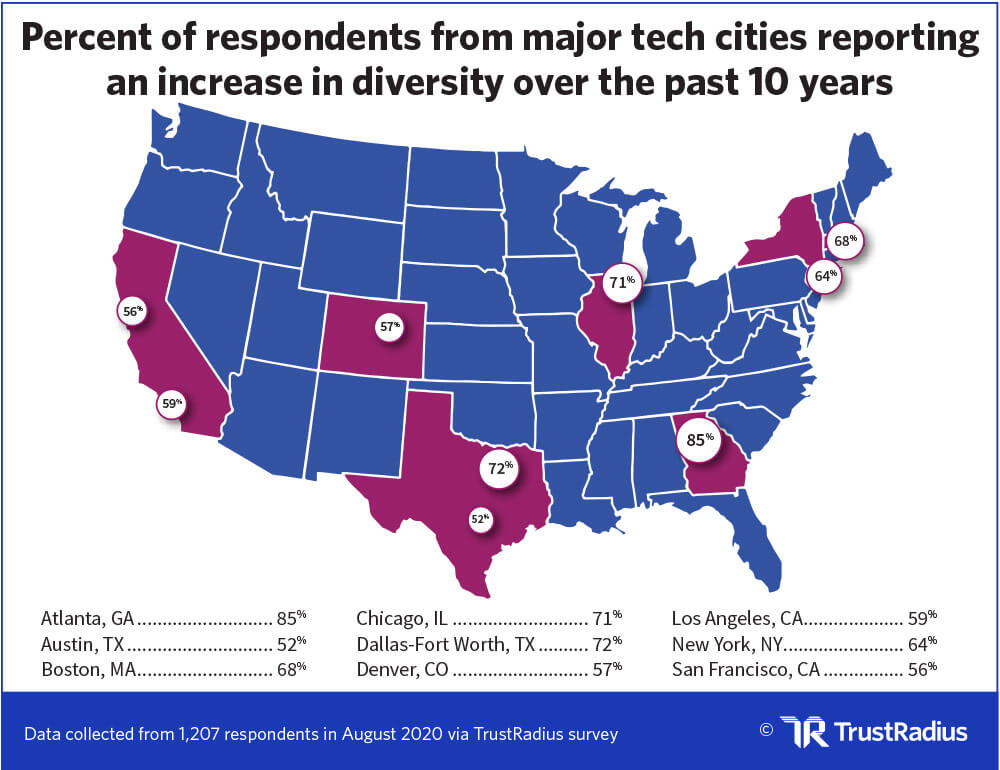
Meet Aruna Ravichandran
CMO & VP of Marketing, Webex/Collaboration at Cisco
“No one intentionally sets out to create unequal workplaces, but they inevitably do arise due to the predilections of people.”

Entering The Tech Industry
Aruna Ravichandran is CMO & VP Marketing for Cisco, with an MBA and Masters in Computer Engineering from Santa Clara University. Her parents always encouraged education in STEM, so she chose a Computer Science path in college. While Aruna enjoyed working with software, she discovered her true calling was working with customers to create better products and then sell them, so she transitioned into marketing.
Challenges for People of Color
“The biggest challenges are unconscious bias, and finding ways to help people see unique talents outside of color. No one intentionally sets out to create unequal workplaces, but they inevitably do arise due to the predilections of people.”
“Also, companies need to be willing to call one another out when unconscious bias arises. This will improve the conversation…”
The Changes Needed
“People ought to amplify and showcase the achievements of their colleagues. Also, companies need to be willing to call one another out when unconscious bias arises. This will improve the conversation, even if the source of complaints is from lower-ranking employees speaking up to management and director level members.”
Advice to Aspiring Young Tech Professionals of Color
“Follow your passion and your heart. When you do what you love, success will come and you’ll have fun on the journey. Also, don’t take no for an answer. If you know your path and are doing what you love, then pursue that with dedication and mindfulness. Look for mentors on the way. Stay focused on the outcome.”
Leadership
Another key aspect of representation for POC in tech is whether or not a company’s leadership team is as diverse as their locales, or as the tech industry overall. Having an all-white leadership team, especially in minority-majority cities, sends mixed signals to POC employees.
“The biggest challenges for POC in tech right now: We don’t see people of color in higher up positions, not seeing yourself represented, lack of support system.” – POC survey respondent
As the U.S. in particular moves towards being a majority POC country in the upcoming decades, it will be important for the tech industry to consider who they’re hiring and placing into positions of power. Tech companies operating globally must evaluate diversity in their workforces and leadership, too. Representation lags behind the changing face of the U.S., not to mention countries that are already majority POC. In this aspect, the tech industry has plenty of progress to make.
Only 21% of tech professionals report that their company’s leadership teams are more than a quarter POC. 67% report their leadership teams are ¼ or less POC. 12% are not sure.
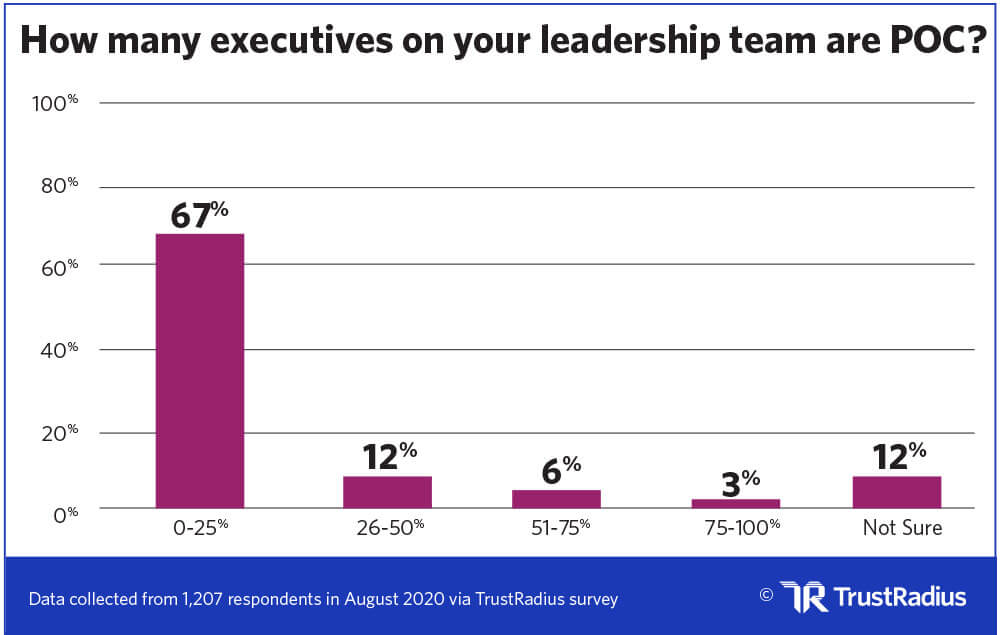
D&I standards recommend that companies’ demographics reflect their country or region. 60% of the U.S. population is non-Hispanic/Latine white, so for the country to achieve greater equity, leadership and workforces should reflect that. However, this is a controversial stance. Some in the field believe it is more appropriate to look at city and/or state demographics, while others benchmark diversity against their competitors or nearby companies of a similar size. Others do not believe in diversity benchmarks at all.
Because there are no laws governing representation, it is ultimately left to company leadership to form an opinion. Regardless of whether a business chooses to adopt this standard or not, it cannot be ignored that the tech industry is overwhelmingly white even in areas where racial demographics are more evenly split.
“The biggest challenge for POC in tech right now is the lack of representation and leadership that reflect us. I’ve worked within the industry for 11 years and have had 2 black co-workers who were on a related team, and zero black co-workers who worked on my team. Thinking about IT or extended tech teams, I’ve worked with a total of 5 black males and ***1 black female.
I’ve worked with HUNDREDS of people directly related to technical teams considered when presenting those numbers and I’ve only worked with a total of ***6 black people. I tend to feel slightly like an outsider, with a minor consideration of my differences that most people I work with never consider.” – POC survey respondent
Thankfully there are organizations specific to the tech industry that are trying to close the gap in representation for people of color in tech. Code2College, for example, does great work with students of color to get them internships in tech which can then turn into full-time jobs. Other organizations like Black Girls Code work with young women of color by teaching them how to code from an early age. These organizations aim to pique an interest in tech when traditionally children of color are not exposed to the tech industry as a possibility. Companies can partner with these organizations as a first step into diversifying the talent pool and their workforces. Another way is to partner with Historically Black Colleges and Universities or historically Hispanic-serving institutions to recruit graduating seniors.
“To be general, the biggest challenge is building POC awareness of the tech field. With most of our parents being blue collar workers, it is rare for POC to even choose these career paths from the beginning. As I mentioned before, we are pushed toward blue collar jobs at an early age and most are unaware of these career options.
I am a first-generation college student with a single mother who was a corrections officer. The process of even beginning to apply for college was quite isolating and overwhelming. I never really understood my career options until my junior year of college. We really need more people reaching out to POC youth about the tech field.” – POC survey respondent
Meet Matt Stephenson
CEO & Co-Founder at Code2College
“The mission of Code2College is to dramatically increase the number of minority and low-income high school students who enter and excel in STEM undergraduate majors and careers.”

Entering The Tech Industry
Matt Stephenson, Co-Founder and CEO of Code2College, is a career educator and finance professional who galvanizes a skills-based volunteer ecosystem to prepare minority and low-income high school students for STEM majors and careers. Originally from New York and a first-generation Jamerican (Jamaican-American), Matt has driven opportunity and access for diverse and underserved students in a variety of roles. While his collegiate focus was on finance, Matt always had a passion for Computer Science and education which led him to help found Code2College.
Matt holds an M.B.A. in Entrepreneurial Management from The Wharton School and a BS in Finance and Information Systems from the Stern School of Business at New York University.
About Code2College
“The mission of Code2College is to dramatically increase the number of minority and low-income high school students who enter and excel in STEM undergraduate majors and careers. By providing youth employment opportunities to those in Code2College, students are given a chance to begin professional development from an early age.”
Technical projects not only allow students to further develop their newly acquired skills and put them into practice but also provide a demonstration of content mastery to both prospective colleges and employers.
The Code2College program model encompasses four components:
1. After-School Coding Sessions
Program participants attend after-school coding instruction sessions twice weekly throughout the school year. Code2College has developed a full-stack web app curriculum that incorporates front-end, back-end, and database technologies.
2. Technical Portfolio Development
During nearly every after-school coding session, students save their projects on their public GitHub accounts. Technical projects not only allow students to further develop their newly acquired skills and put them into practice but also provide a demonstration of content mastery to both prospective colleges and employers.
3. Monthly Professional Development Workshops
Each month, program participants visit a corporate partner office and meet with STEM industry professionals, Code2College staff, and volunteers to develop a variety of professional skills including resume construction and interview prep. In addition, students participate in a variety of industry-relevant case competitions and STEM exploratory projects (e.g. portfolio management case competitions and AGILE methodology activities).
4. Summer Internship/Consultancy
The culmination of the Code2College program year is the paid, project-based internship or consultancy which occurs during the summer following the school-year programming. Students work either on-site with an internship host or off-site on a consultancy project for a business client.
How POC Identify
Another important aspect of representation for POC in tech is how to address them as a collective. Words are important and can be a source of microaggressions as cultural tides shift. We wanted to get a pulse on what the preferred term for people of color is from POC themselves. There is a big debate right now regarding whether to refer to people of color collectively as BIPOC (Black, Indigenous, and People of Color) vs POC, or use more specific terms when discussing racialized experiences.
29% of POC respondents prefer the term “People of Color,” followed by “BIPOC” with 22%. 22% have no preference while 7% prefer that specific terms such as Native, Black, Latine, etc. be used whenever possible. 20% prefer the term “minorities,” which is the more historically popular term.
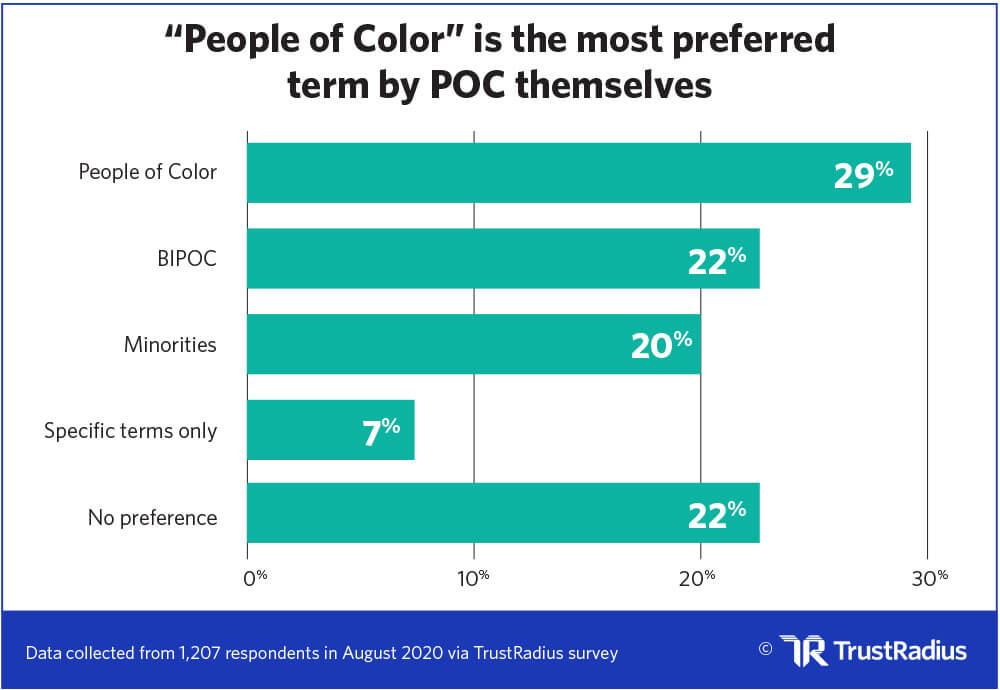
40% of white respondents chose the “no preference” response. This may indicate a sizable contingent of white tech professionals who are looking for more guidance on how to better support their POC peers. It may also indicate that white respondents look to POC to self-define and use the terminology their POC coworkers prefer to use for themselves.
“The biggest challenge for POC in tech right now is being lumped into a single category such as People of Color. There is a huge chasm between the opportunities available for people of Asian and South Asian descent than there are for people of Latino and Black descent.
That is not to take away from the struggles that Asian and South Asian people face, but it’s not equal, and generally we see race in this country as Black and White or as White and Other. We need educational programs, and opportunities, that specifically target the Black and Latino communities.” – POC survey respondent
For more information on the history of newer terms like BIPOC (Black, Indigenous, & People of Color), check out this informative article from Vox which provides insight into how these terms came to be and how to most accurately use them when addressing diverse audiences. In regards to “Latine,” this is a more commonly used gender-neutral term than the traditional “Latino.” It also respects both English and Spanish grammatical rules—unlike “Latinx,” which is typically defaulted to an English pronunciation that does not flow as well in everyday conversation for Spanish speakers.
Meet Manny Medina
CEO at Outreach
While Manny did not grow up with much exposure to tech, in college he started studying computer science and became enamored with coding.

Entering The Tech Industry
Manny Medina is the CEO of Outreach in Seattle, Washington, with an MBA from Harvard Business, and an MS in Computer Science from the University of Pennsylvania. He grew up in Ecuador, from a lower-middle-class background. While he did not grow up with much exposure to tech, in college he started studying computer science and became enamored with coding. However, he saw a ceiling to the career he could achieve as a programmer in his home country. So, he transferred to the US, finished his education, and initially designed the billing system for Bell Atlantic, which eventually became Verizon.
“At times, stereotypes about my accent or heritage have made people think I was a manual laborer, resulting in condescension and lowered expectations. CEO status was not perceived to fit my mold, especially while raising capital.”
Road to Current Role
“I felt coding was not my forte after I worked with others I perceived to be more skilled at it than I was; this allowed me to understand that I am a better fit for project management, fundraising, and leading ideas within the tech sector. After grad school, I worked for Amazon and Microsoft, among others. I became skilled with angel and VC fundraising, cultivating a network of people that fomented the reputation of my endeavors.”
Challenges for People of Color
“As a non-native English speaker, I have to do additional interpretation cycles of translating ideas to Spanish mentally that monolingual English speakers don’t experience. At times, stereotypes about my accent or heritage have made people think I was a manual laborer, resulting in condescension and lowered expectations. CEO status was not perceived to fit my mold, especially while raising capital. I could sense the weight of being judged in meetings, down to the way I was spoken to and addressed. This resulted in self-doubt. Now I am more motivated to provide an environment that avoids allowing people to feel similarly judged like I did.”
“Social awareness of systemic oppression like racism is trending upward. Harness this attention and energy. Meet people where they are, and bring their opinions into the colloquial conversations within the company.”
The Changes Needed
As a CEO, Manny offered perspective on leading a more diverse corporate culture: “Start with the long view and big picture in mind. Set explicit goals like diversity representation initiatives, connecting elements of the corporate pipeline to support all employees, discouraging churn, and rooting out insidious sources of discrimination.”
Advice to Aspiring Young Tech Professionals of Color
“Social awareness of systemic oppression like racism is trending upward. Harness this attention and energy. Meet people where they are, and bring their opinions into the colloquial conversations within the company.”
Operationalizing Diversity & Inclusion
With recent events in the U.S. highlighting the stark contrast between the lives of people of color—particularly Black Americans—and white Americans, the topic of diversity and inclusion has reached an all-time high. Companies across industries are under pressure to address how inequality permeates their own offices.
Diversity and inclusion departments began as a way to combat discrimination and inequality by including racialized groups and other minority groups such as LGBTQ+ individuals and religious minorities at the forefront of the workforce.
D&I Departments and Executives
Some tech companies have begun to address the lack of diversity by dedicating staff to manage their Diversity & Inclusion (D&I) efforts and bring tough conversations to the forefront.
Diversity and inclusion departments began as a way to combat discrimination and inequality by including racialized groups and other minority groups such as LGBTQ+ individuals and religious minorities at the forefront of the workforce. These departments work to operationalize D&I by making pay more equitable and transparent across job titles, celebrating all holidays relevant to your employees (and not just defaulting to the majority’s holidays), and supporting individuals with non-traditional families in terms of healthcare and benefits.
While ideally every major company would have a D&I-focused executive, or even an HR professional with a strong D&I contingency, our research indicates this is not the case. Less than half of respondents work at a company with a D&I department or D&I-focused executive.
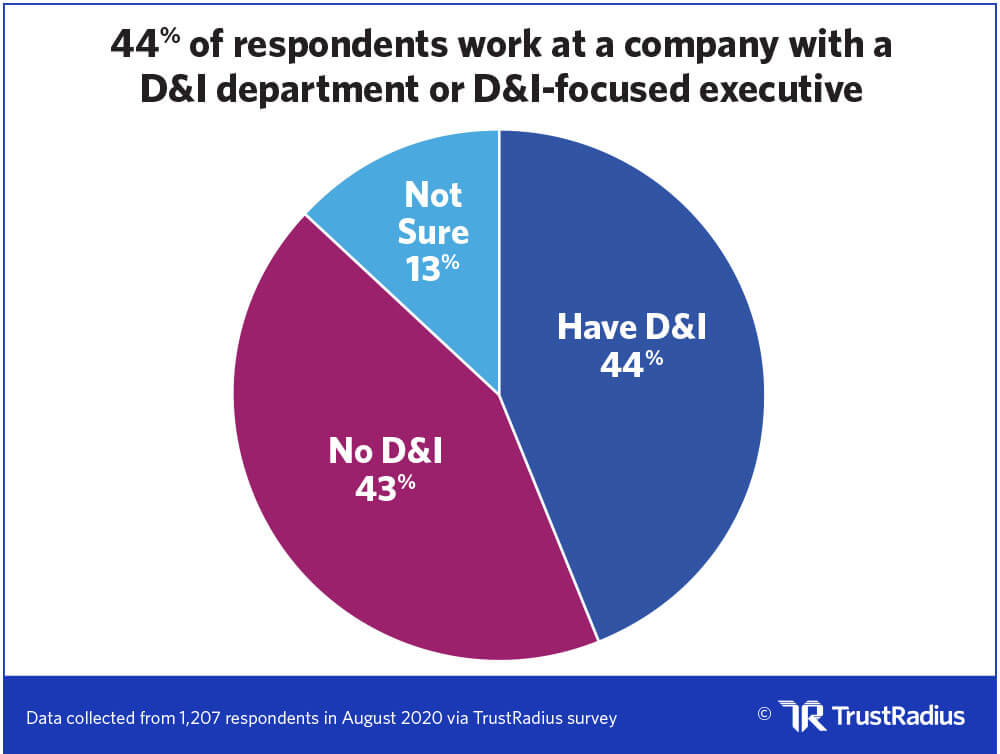
However, there does appear to be a correlation between company size and the likelihood of having a D&I department or executive, with D&I outfits being more common at enterprises. Smaller businesses may not have the financial capacity to support a dedicated D&I professional and thus may opt for hiring HR professionals with D&I backgrounds. Ezinne Udezue, profiled earlier in this report, warns against startups and smaller businesses using finances as a reason to not invest in D&I, as there is a monetary cost to less diversity.
Meet Stephanie Herrera
Global Vice President, Salesforce Practice at Computer Futures
Stephanie is passionate about changing the perception of what an “ideal candidate” looks like and championing more diverse personalities and histories within tech.

Entering The Tech Industry
Stephanie Herrera is currently the Global Vice President of Computer Futures’ Salesforce Practice, helping those with an interest in growing their skill sets with Salesforce or looking for a career within a community environment. She also serves on the Board of Directors for Mervis, a non-profit that works with veterans interested in working in cloud computing, as well as Co-Founder of PepUp Tech, an organization that works with minority groups to get more people into tech.
Stephanie has a non-traditional background in tech, working her way up from an entry-level tech sales job to where she is now without attending college. She is passionate about changing the perception of what an “ideal candidate” looks like and championing more diverse personalities and histories within tech.
Road to Current Role
“I have made a name for myself within tech by working hard to provide access to the tech industry to those who do not typically have access. My experience with working alongside both startups and enterprises led to my current role with Computer Futures when at the time of my hiring, I was the only Vice President to ever be brought in from outside the organization. My own personal goals and passions aligned very well with Computer Futures, which is why I took the offer.”
“Income inequality must also be addressed as an issue of diversity & inclusion—companies should pay employees in similar roles equally, and experience should be valued as much as a formal college education and vice versa.”
The Changes Needed
“I am a champion for equal pay. Income inequality must also be addressed as an issue of diversity & inclusion—companies should pay employees in similar roles equally, and experience should be valued as much as a formal college education and vice versa. Without equal pay and respect for tech professionals from non-traditional backgrounds, suitable candidates are left without the opportunity to pursue a career in the field. My biggest message to companies: get serious about diversity & inclusion and put words into action.”
“My biggest message to companies: get serious about diversity & inclusion and put words into action.”
Advice to Aspiring Young Tech Professionals of Color
“Just do it! I believe that now more than ever there is so much opportunity and so many possibilities for people of color to pursue their dreams in tech. I advise young tech professionals of color to never be afraid of reaching out to a potential mentor and network, network, network.”
Does D&I work?
Not everyone is convinced that D&I works, let alone that it’s necessary. There is a major discussion within the tech industry right now on whether or not tech needs D&I at all.
When asked whether or not D&I initiatives are actually effective, 60% of TrustRadius survey respondents reported that they do believe D&I initiatives can be effective, very effective, or extremely effective. Only 14% of respondents see D&I initiatives as not at all effective.
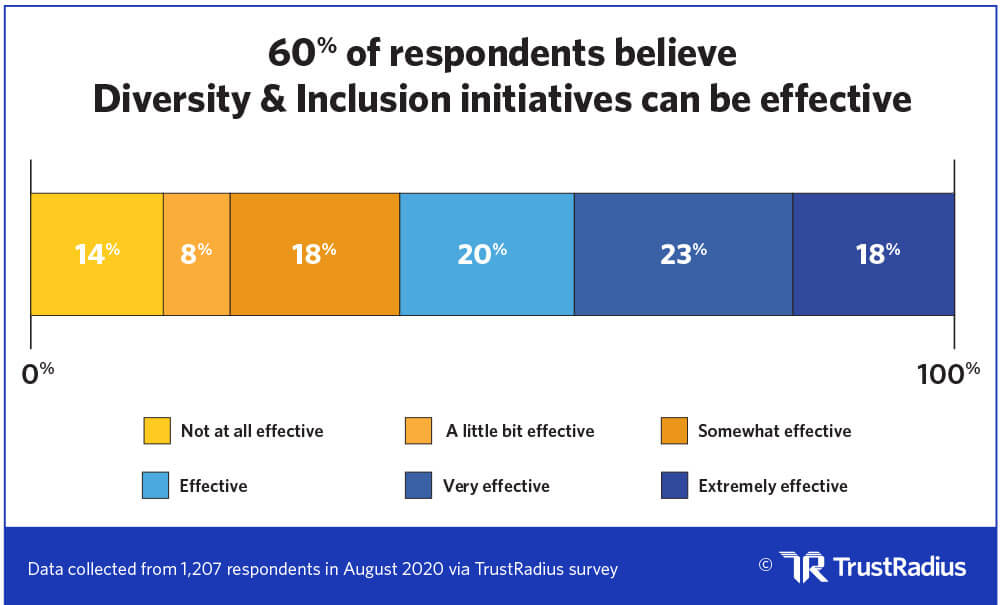
This is important data for tech leadership teams to have as they plan their own companies’ approaches. Tech professionals are interested in making D&I work, so leadership teams should invest in its execution and success. This is crucial in changing the trajectory of who makes up the tech industry, and determining whether or not the tech industry is committed to retaining diverse hires.
While 81% of white respondents reported never having any issues at work due to their race or ethnicity, 43% of POC reported that they have.
Diversity and inclusion are so relevant in tech today because many POC still face discrimination not only outside of work but in the office as well. While 81% of white respondents reported never having any issues at work due to their race or ethnicity, 43% of POC reported that they have. Of the 19% of white tech professionals who did report issues, all were of ethnic minorities, such as Latines, who despite being white, experienced xenophobia at work.
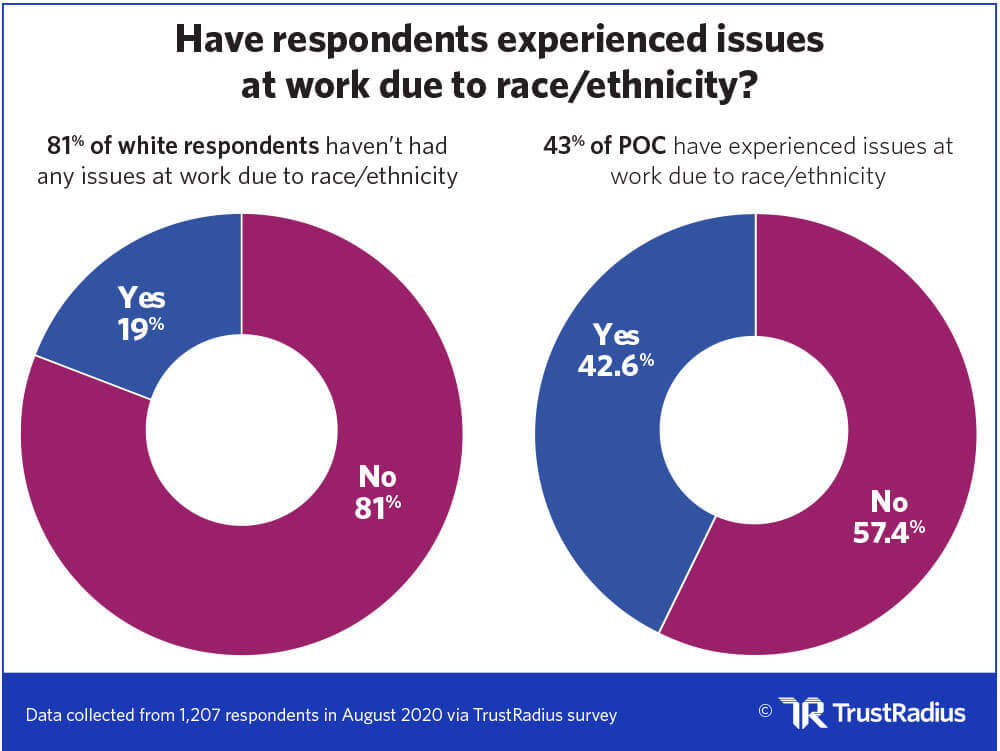
Despite there being a gap in workplace discrimination for white respondents and POC respondents, they believe in the effectiveness of D&I initiatives at similar rates, 61% and 62% comparatively.
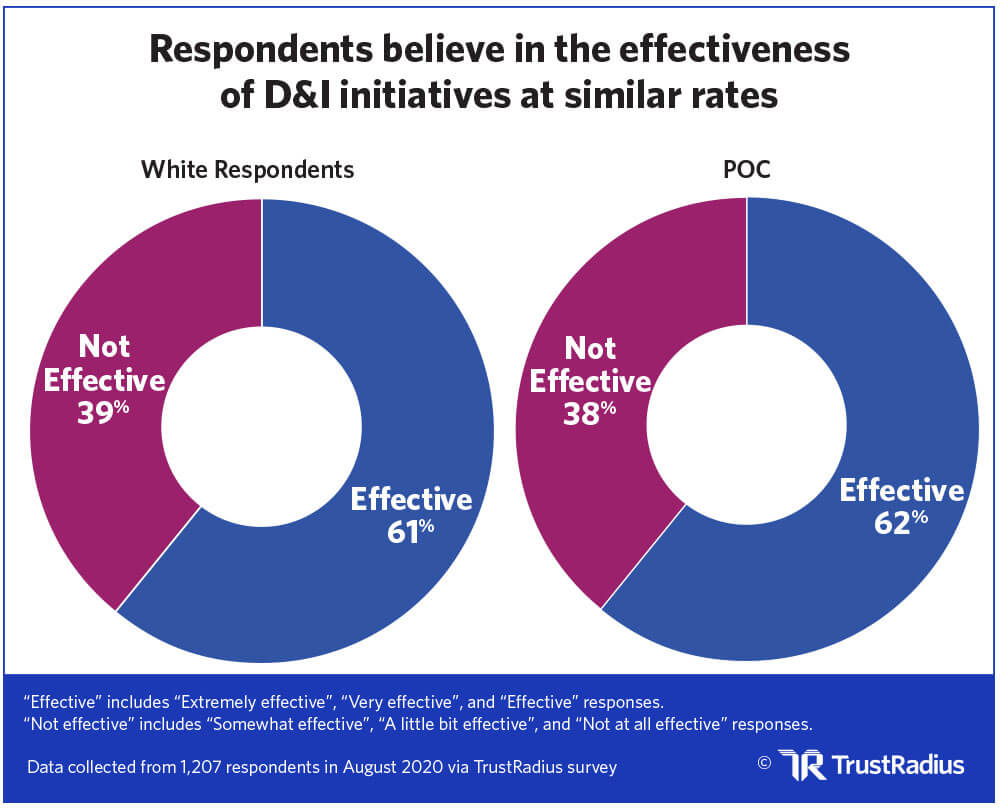
Tech CEOs & founders are more divided on the issue than other positions. Across all job titles and levels, they are the least likely to believe D&I initiatives to be effective, 51% compared to 62% overall.
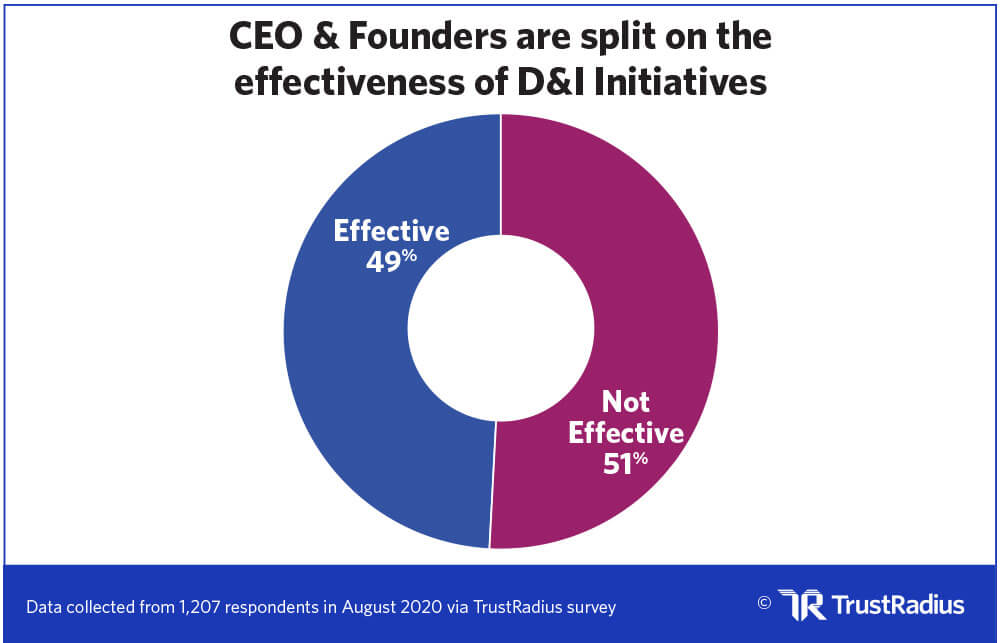
Tech leaders are in a tough position of protecting their POC employees while motivating their entire workforce, regardless of ethnicity, to embrace the tenets of D&I such as addressing unconscious biases and unlearning harmful behaviors or attitudes. This may be why many leaders are disillusioned with D&I initiatives. (However, there are several easy, digestible resources below for busy tech leaders who need a strong business case for D&I.)
As the U.S. itself diversifies, tech leaders will be left with the responsibility to decide: take action, or stick with the status quo and be left behind as other major companies cement their dedication to addressing inequality. It’s also important for tech leaders to recognize that there are more obstacles to joining the tech industry beyond representation, such as unequal education, lack of access to internships, and more. D&I initiatives can help address all of these issues at once, and galvanize allies in the workforce to help make tech more equitable.
Resources on how to put Diversity & Inclusion into action:
- Designing a D&I policy: Harvard Business Review
- Example of how to recognize diversity: Fast Company’s Queer 50 List
- How To Measure The ROI Of Diversity Programs: Forbes
- Driving Diversity and Inclusion—the Role for Chairs and CEOs: Harvard Law
Meet Rakhi Voria
Director, IBM Global Digital Sales Development
According to McKinsey’s 2019 Women in the Workplace study, women of color represent only 4% of the C-suite and only 7% of VP roles, with little to no improvement over the past five years.

Entering The Tech Industry
As the Director of Global Digital Sales Development at IBM,
Rakhi Voria manages a team that is responsible for the strategy, implementation, and revenue of the Digital Sales Development function globally. A daughter of Indian immigrants, Rakhi grew up in the U.S. and earned full scholarships to the University of Oxford where she received her M.Sc. and Colorado College where she received her B.A.
Like many millennials, Rakhi was interested in working in an industry that was changing the world and ended up joining Microsoft after attending a recruiting event at Oxford. Through her studies, she saw the challenges that people faced all over the globe and wanted to work in an industry that had the ability to do something about it. Despite not having a technical background, she was attracted to the vision and breadth of the company and had seen the impact that technology had made even in her own life growing up.
“My biggest piece of advice is to throw out the idea of a career ladder and instead focus on gaining a set of skills and experiences that will set you up for the long run.”
Road to Current Role
“Last year, I joined the Conversions with Women in Sales podcast and shared a bit about my decision to switch companies and take on a new leadership role at IBM (click here to listen to the episode). It was a transition that made a lot of sense for me for a variety of reasons.
In terms of how it happened, I had been involved in an industry organization for digital sales leaders, the American Association of Inside Sales Professionals (AA-ISP) Enterprise Executive Forum, and met IBM’s Vice President of Digital Sales who invited me to have a conversation about opportunities on his team. After a few informal meetings with some incredible IBMers, I was sold on the company, the people, and the job itself. It was a chance for me to continue working in the field of digital sales, an area that continues to grow as customer buying preferences shift toward digital engagement, and as emerging technologies like AI enable deep analysis and rich customer conversations like never before.”
The Changes Needed
“I’d like to see more women of color in senior leadership roles in technology. According to McKinsey’s 2019 Women in the Workplace study, women remain significantly underrepresented across all management levels in business. Women of color in particular represent only 4% of the C-suite and only 7% of VP roles, with little to no improvement over the past five years. Susan Colantuono, CEO of Leading Women, believes that this may be because career advice for women is often centered around personal branding, networking, confidence, and self-efficacy as opposed to tools to increase business strategy and financial acumen.
“I’d also like to see more diversity across the business functions within technology, particularly the sales function. Women in particular are underrepresented across all levels in sales.”
I’d also like to see more diversity across the business functions within technology, particularly the sales function. Women in particular are underrepresented across all levels in sales. CEB Global reports that the sales function has the second largest gender equity gap of all corporate functions after supply chain. I recently published two articles in Forbes on this topic (Why We Need More Women in Sales and Why Women Should Consider Roles in Sales) as a way to bring attention to this issue. We need companies to commit to action and to break down barriers preventing women from entering and advancing in the sales profession.”
Advice to Young Tech Professionals of Color
“My biggest piece of advice is to throw out the idea of a career ladder and instead focus on gaining a set of skills and experiences that will set you up for the long run. The traditional notion of a linear career path and “climbing the ladder” no longer exists. Because there’s no universal path to success, focus on broadening your skillsets and experiences.”
Industry Performance
How do tech professionals rate our industry in terms of stepping up to the plate to address inequality? Not well. 66% of respondents think tech companies could do more to address racial inequality. 18% think companies are doing enough, and 15% think companies are actually doing too much.
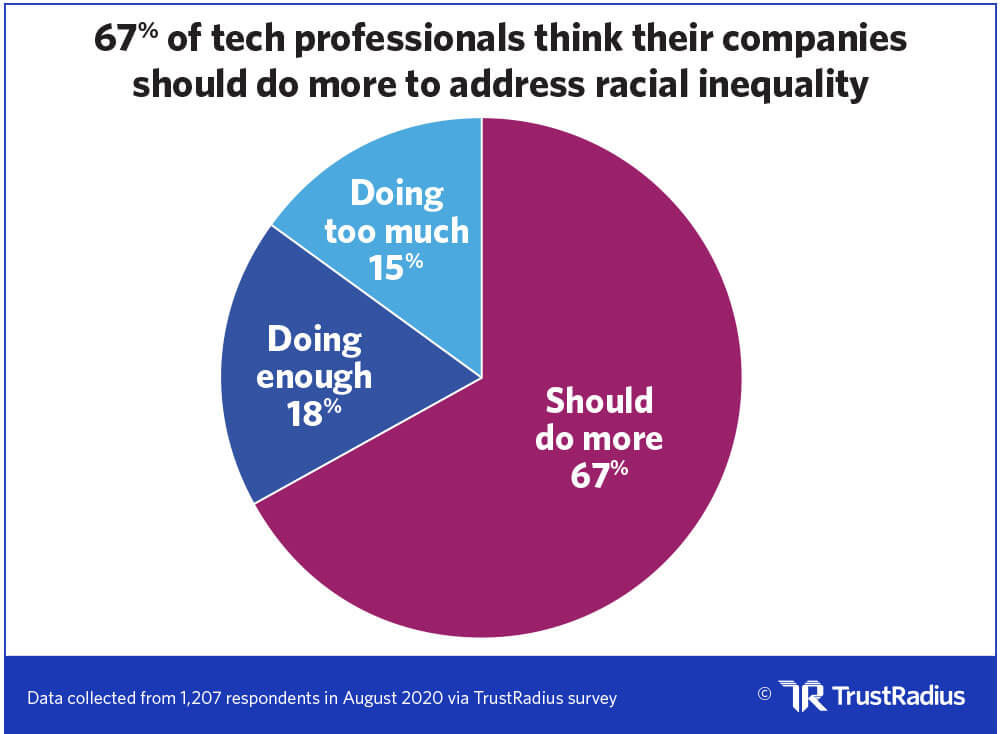
People of color are more likely than white respondents to want their employers to do more to address inequality. Being that POC are also more likely to experience racial discrimination, it tracks that they think companies are not doing enough to address this.
It’s important to note that 58% of the respondents who said companies are actually doing too much identified as non-Hispanic white. This indicates a potentially major barrier to progress—that the largest group doesn’t seem to have a problem with the status quo, and may even prefer the status quo.
This is a good cue for white tech professionals to think about their relative position in the industry compared to their peers. It may be helpful for white tech professionals to reflect on the opportunities and privileges they’ve received, to self-educate about microaggressions, unconscious bias, pay inequity, etc. and to reach out to POC in their companies to see what they can do to be allies.
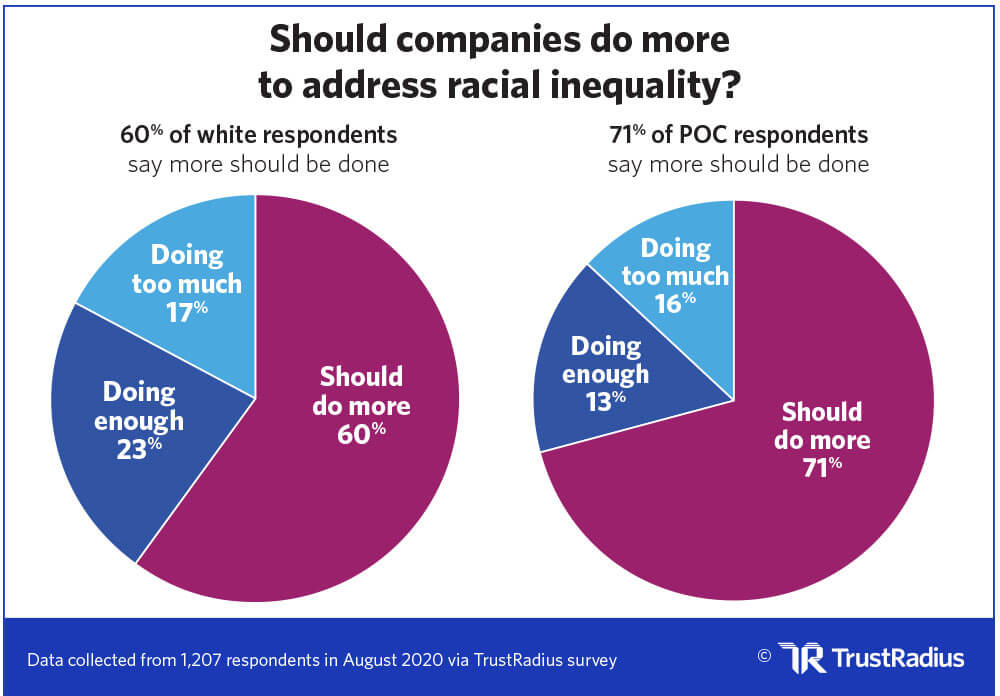
VC Funding Gap for POC-owned Startups
One way racial inequality appears in tech is in venture capital funding and the access POC entrepreneurs have to backers. POC entrepreneurs have a harder time finding backing or receive less backing than white founders. In 2017 only 1% of VC startup founders were Black and 0.4% were Latine. According to research by Morgan Stanley, 3 out of 5 VC firms say that investing in diverse entrepreneurs is not a top priority for their firms.
According to research by Morgan Stanley, 3 out of 5 VC firms say that investing in diverse entrepreneurs is not a top priority for their firms. This study also finds that VC firms themselves tend to also be less diverse, with fewer women and fewer POC.
Manny Medina, CEO of Outreach, experienced this challenge firsthand. “When I was fundraising, I used to get a lot of ‘no’s. It’s normal to get a lot of ‘no’s, but many of the rejections I got were just disrespectful. They were interested in my product, but didn’t see me as a CEO because of my ethnicity, my accent, and background. The momentum would be great until they met me face-to-face. I’ve seen other POC entrepreneurs get the same treatment.”
We asked respondents to share how much or how little they were concerned with this gap in VC funding, given that it greatly affects the number of POC tech leaders in the industry and their access to capital. 65% of respondents are fairly or very concerned about the VC funding gap for POC-owned startups, indicating that the industry overall is looking towards change in this regard.
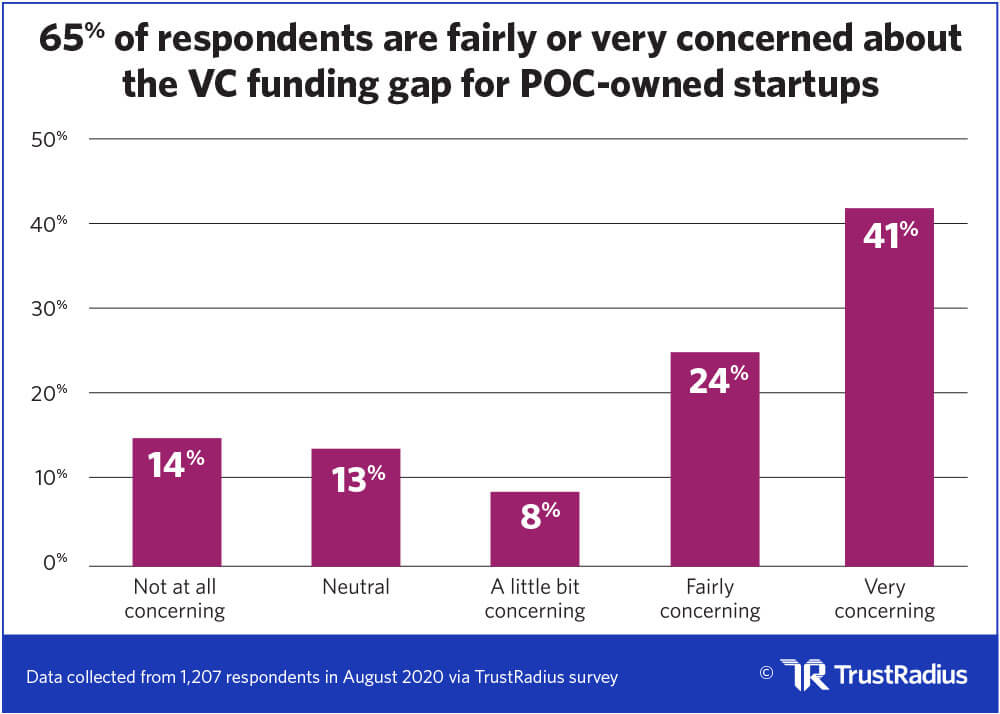
However, there seems to be a correlation between job position and concern about the VC funding gap—the higher the position, the less concerning tech professionals find the issue. Compared to all other titles ranging from entry-level to Vice President, tech CEOs, founders, and principals are the least likely to be concerned about the gap in VC-funding for POC-owned startups.
The aforementioned Morgan Stanley study also finds that VC firms themselves tend to also be less diverse, with fewer women and fewer POC. VC firms also might not include diverse entrepreneurs in their ideas for what are appropriate fits or expansion risks, perhaps due to unchecked unconscious biases in this space.
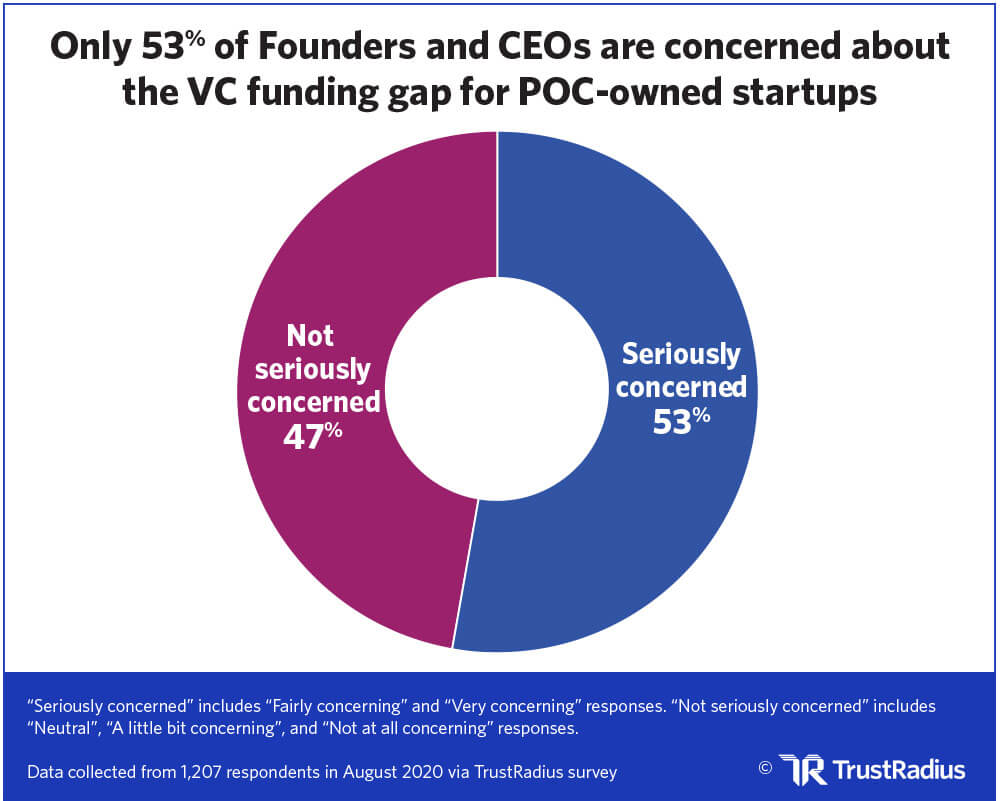
Tech leaders seem split on whether or not they’re seriously concerned about the VC funding gap. This could be particularly disheartening news to POC tech professionals who may feel that the industry’s most important figures do not support them. Black respondents in particular are the most likely to be concerned about the gap, with 80% seriously concerned.
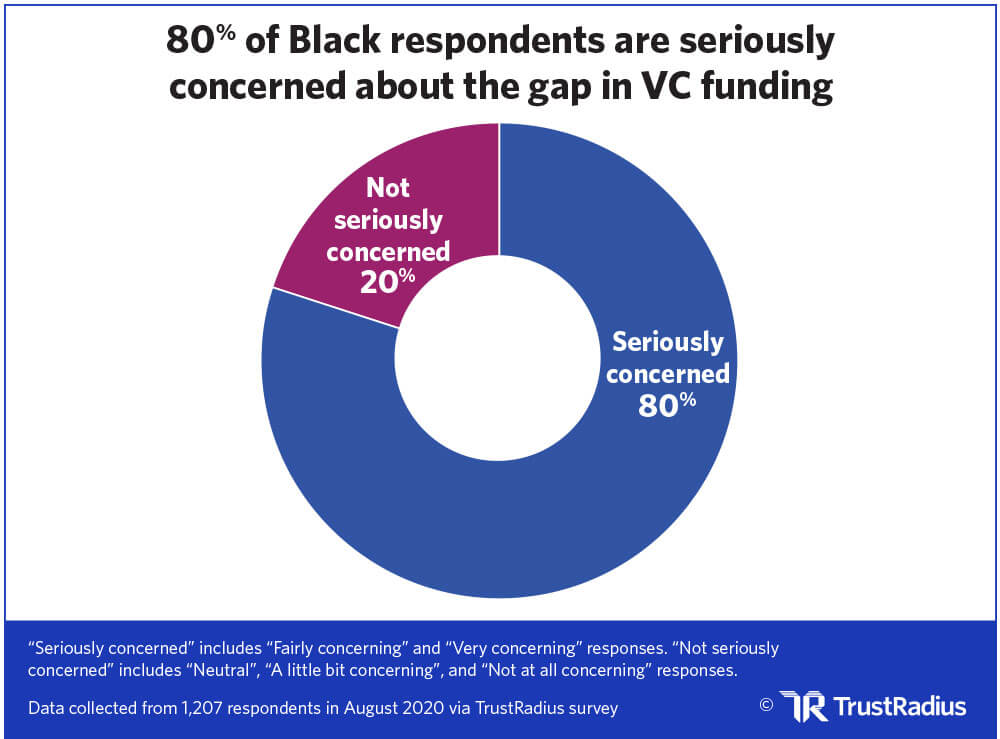
The greater concern from Black respondents is most likely related to data which highlights the VC gap in general for Black entrepreneurs compared to their white peers. Another reason may also be their relative lack of representation in the tech industry compared to their overall percentage of the total U.S. population.
When asked why there is a gap in VC funding for POC, the most commonly cited reason by survey respondents is that POC don’t have the same connections or network as white tech professionals. An equal number of respondents believe this is because POC do not have much representation at VC firms themselves.
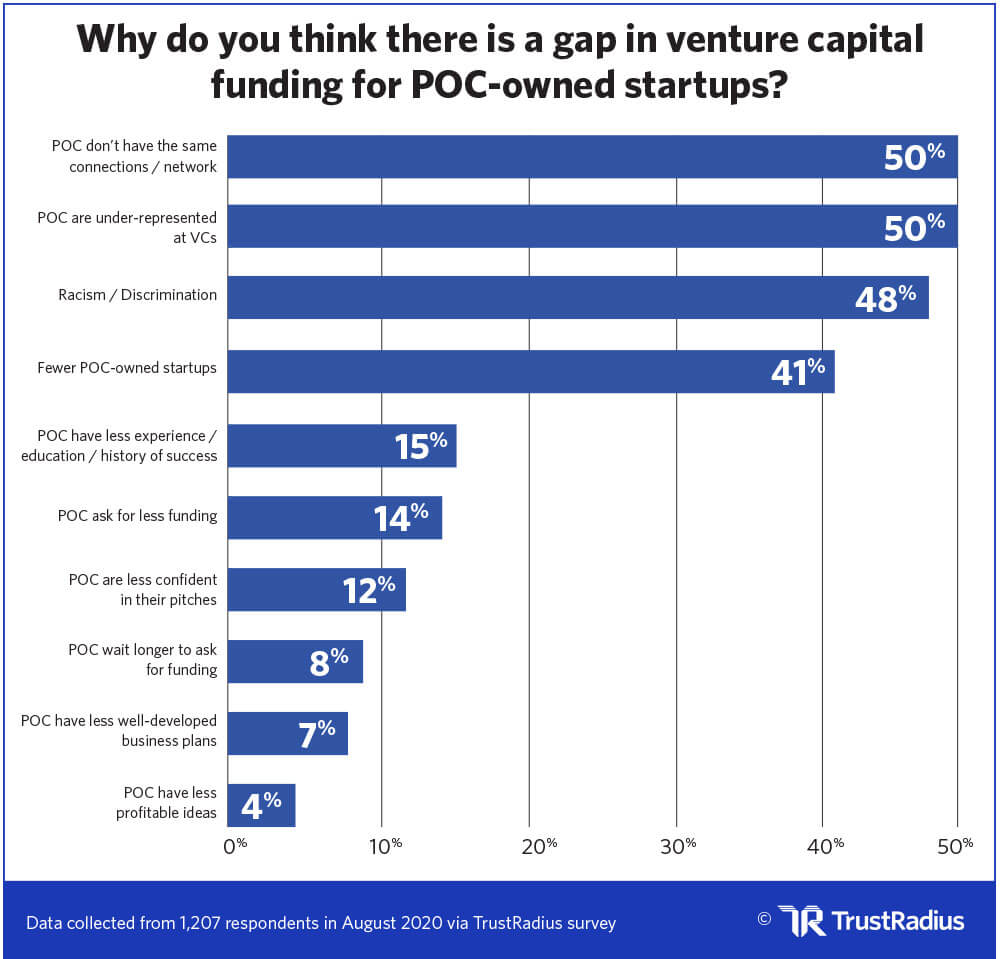
“The biggest challenge for POC in tech right now is unconscious bias. Most VCs don’t have to care about diversity because they are positions of extreme privilege. They literally decide what ideas are good and by inference who is good.
The answer to that question is overwhelmingly white. POCs have a better shot at funding from foreign sources due to their emphasis on merit rather than appearance.”
– POC survey respondent
– POC survey respondent
Meet Merrell Ligons
Customer Success Manager at TrustRadius
“There are far too few mentors and role models in the tech space for people of color.”

Entering The Tech Industry
Merrell Ligons is a Customer Success Manager at TrustRadius. He studied Web Development and Management Information Systems in college, so he always had his eyes on tech. His first tech job out of college was as a Help Desk Technician at a local newspaper. While working swing shifts and weekends he was actively working on building his web development skills. Word got around that he could do some web programming and he moved to the advertising department to work on developing early online classified advertising programs for the automotive and real estate markets.
Biggest Challenges
“There are far too few mentors and role models in the tech space for people of color. We need mentors and role models who would be willing to guide and to inspire the next generation of minority tech leaders—a Michael Jordan or Lebron James of technology.”
“Nobody is going to just give you an opportunity to join the tech industry, you have to pursue it.”
The Changes Needed
“It starts at the top. Structurally there has to be more diversity at the executive level and a true commitment to a diverse and equal playing field in the organization. More tech leaders need to admit that the industry is not culturally diverse and publicly commit to making the industry and their company a better place for people of color.”
Advice to Aspiring Young Tech Professionals of Color
“Nobody is going to just give you an opportunity to join the tech industry, you have to pursue it. The tech industry has its challenges. I feel it’s better in some ways than other industries, but not perfect. There will absolutely be setbacks, roadblocks, and disappointment, but these things aren’t unique to our industry. You must have the ability to persevere and break through these challenges if you want to succeed.”
Challenges
Mentorship
Receiving mentorship is a key component of career progression for many tech leaders. However, POC may find it difficult to connect with a suitable mentor. This is one way they are at a disadvantage to their white peers.
Black respondents are the most likely to report difficulty with finding a mentor, at 63%. Out of other POC groups, Asian respondents are the least likely to report difficulty finding a mentor, at 41%. This is on par with the proportional representation of Asian people in the tech field relative to their overall share of the general population of the United States. Still, Asian respondents along with Black, Latine, and American Indian, Alaska Native, Native Hawaiian, or Other Pacific Islander respondents report more difficulty finding a mentor than white tech professionals.
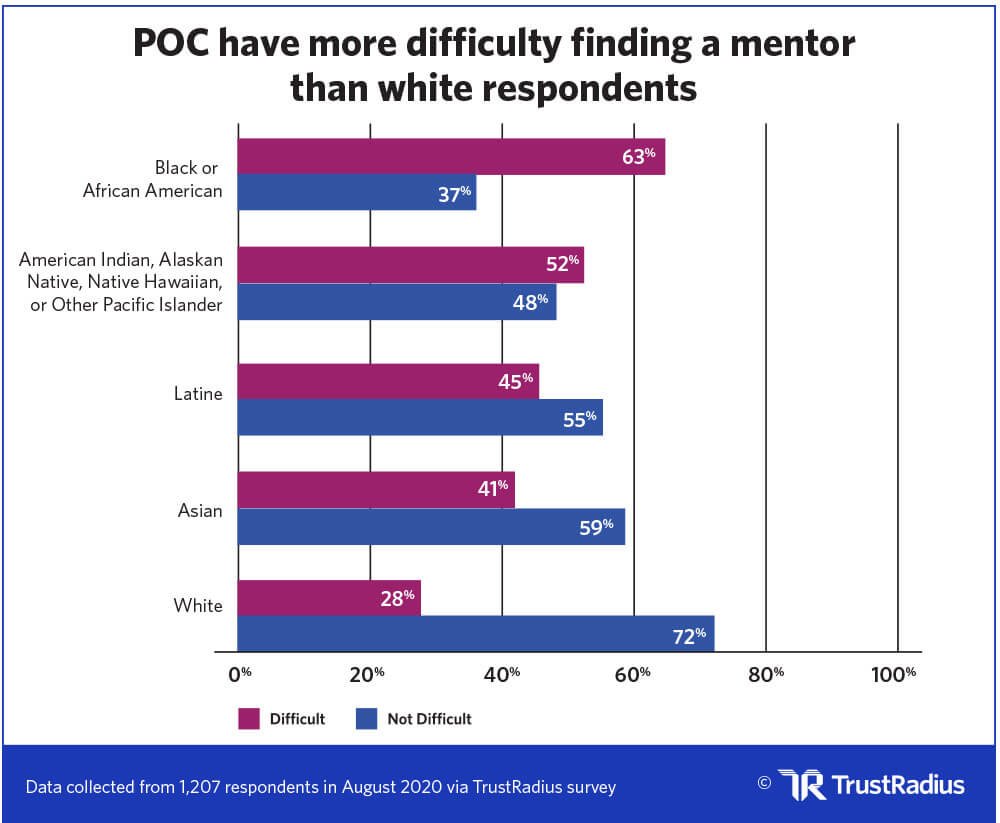
One way to improve the ease with which Black and other POC respondents can find mentors is for POC leaders in tech to provide outreach to new tech professionals of color. White tech professionals can support this type of intra-POC solidarity by offering to mentor POC in tech themselves. Creating interracial mentorships is one way to bridge both social and economic gaps for tech professionals and address biases and stereotypes that come into play before a job is even secured.
Unconscious Bias and Hiring
There is some disconnect between POC tech professionals and white tech professionals in regards to how much biases come into play during the hiring process. Recruiting and hiring are commonly seen as the number one reason for a lack of POC in tech. When racial discrimination is an issue around the world, it cannot be expected for the recruiting industry to be unaffected by racism and prejudices.
Within the tech industry, there appears to be a major gap in perceptions of just how much unconscious bias affects hiring processes. 45% of POC think unconscious bias plays a major role in interviewing and hiring compared to just 27% of white respondents. One way for white tech professionals to be better allies to their peers is by first recognizing just how much unconscious bias, particularly racist unconscious bias, affects who gets hired.
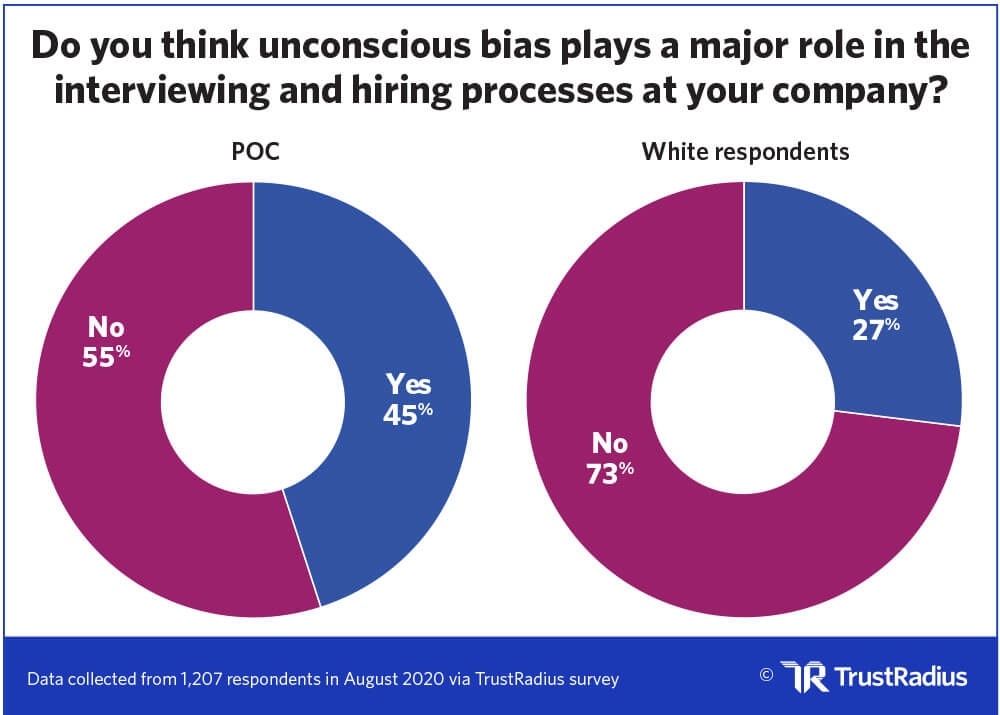
It’s also worth noting that many tech industry hires are made directly through networking—especially upper-level leadership roles. Yet our survey respondents confirm that network-based hiring can be discriminatory.
“A lot of tech hiring happens through networking. In my opinion that becomes a catch-22 situation because if a population is underrepresented in a sector then having connections is also difficult.”
– POC survey respondent
Unconscious bias training is a polarizing topic, but this is one way to get the subject top of mind for tech employees. This kind of training will work best when accompanied by other formalized actions such as institutionalized cross-collaboration between teams both professionally and socially, and formal policies that address racism and other forms of discrimination. One of the biggest ways in which companies can combat unconscious bias is by formalizing consequences for unchecked unconscious bias, microaggressions, and discrimination.
Meet Lashanda Jackson
Senior Manager, Product Marketing at Mailchimp
“Systemic racism permeates the fabric of our society, so it’s unsurprising to see its signatures within corporate culture.”

Entering The Tech Industry
LaShanda Jackson is a Senior Manager for Mailchimp in Atlanta, GA with an MBA in Strategy and Leadership from Rutgers. Her caretaking grandparents raised her, witnessing her flourish with educational achievements that were out of reach to them growing up in the Jim Crow South. She entered the tech industry when she pivoted from the CPG industry to tech, initially working sales and leading training events for HP.
Road to Current Role
Lashanda is a lifelong learner with a passion for learning about customer behavior and needs. This has brought her through various roles in sales, marketing, and research. A recruiter contacted her about an opportunity in Mailchimp, and upon researching the company and its culture, she accepted.
“Racism is often inadequately addressed with so-called ‘bias trainings’ and diversity initiatives, implicitly avoiding solutions like honest conversations coupled with activism out of unease. It is this unease that causes an environment of resistance to initiating dialogues about racism to propagate.”
Challenges for People of Color
“Systemic racism permeates the fabric of our society, so it’s unsurprising to see its signatures within corporate culture. However, within this context, racism is often inadequately addressed with so-called ‘bias trainings’ and diversity initiatives, implicitly avoiding solutions like honest conversations coupled with activism out of unease. It is this unease that causes an environment of resistance to initiating dialogues about racism to propagate.”
The Changes Needed
“Leadership boards, ideally comprised of people of color for varieties of perspective, ought to be courageous in securing a platform for catalyzing commuications about anti-racist efforts and feedback about company character. Goals should be explicitly outlined about these endeavors, with transparent details representing their implementation and progress. These fundamentals need to bolster support and appreciation for employees of color.”
“Leadership boards, ideally comprised of people of color for varieties of perspective, ought to be courageous in securing a platform for catalyzing communications about anti-racist efforts and feedback about company character.”
Advice to Aspiring Young Tech Professionals of Color
“Find your passion, harness it, and learn to cultivate your value around it. You will face adversity, and you will not always have the resources you need. Believe in yourself even when others don’t. It is also critically important that you find a mentor, an advocate, and a sponsor. For inspiration, read Carla Harris’ Expect to Win, detailing how she navigated Wall Street as a Black woman.”
Biggest Challenges for People of Color in Tech, in Their Own Words
When asked what they believe to be the biggest challenges for people of color in tech today, here’s what our survey respondents had to say:
Microaggressions
“White coworkers not realizing they’re being racist.”
“I think that as a POC I’m expected to work harder, faster, and better than my colleagues for less pay—and to be “thankful” for it. There are also lots of microaggressions I’ve experienced in the past, as well as sexual harassment because as a Latina I’m seen as more available for bad behavior.”
Unconscious Bias
“White people feel that people who don’t look like them will create an uncomfortable environment for them because they can’t relate to people of color. The problem in tech is a societal problem. Most people do not have friends that differ from them in color, religion, gender, age. This creates a problem where people are biased to people that look, or sound like them.”
Unequal Access to Education and Opportunities that Build Experience
“The education system in [the U.S.] is terrible. Many POCs grow up in underserved communities, where their poor education leaves them at a disadvantage. Yes, there is more than a pipeline problem, but the pipeline is the biggest issue IMHO.”
“Access to quality education since childhood.”
“We are under represented and are not given the same opportunities (we have to work twice as hard) as our white counterparts.”
“Promotion bias which reinforces hiring bias and lack of appealing entry points into tech.”
“Leadership thinking that we’re less capable in a senior role, or have a limited seniority we can reach.”
Exclusivity in Tech Culture
“Using terms like “right culture fit” or “the best person for the job” are coded terms to say we don’t need to focus on diversity.”
“White people in tech do not see when there is a lack of diversity in race/ethnicity. Or, they overcompensate when they “see”, by including a token 1 or 2 people, usually of Asian culture. It’s a challenge, because the “cultural” or “mission” statements of the companies include the words “diverse” and “inclusive”, but it’s from a White perspective.”
Commoditization of Diversity
“With the recent surge of focus on developing people of color, I worry it will further perpetuate the perception that they are going promoted just because of being a person of color.”
“Needing to solve white peoples’ insecurities around racism/inclusion. We do not need to provide all the answers or educate everyone – we have enough to deal with. I’d like to see more people with privilege educate themselves and be proactive in that rather than asking people of color to guide them.”
Meet Sandhya Srinivasan
Quality Engineering Manager at TrustRadius
“Don’t give up or look back. Work hard and work smart.”

Entering The Tech Industry
Sandhya Srinivasan is a Software Quality Engineering Lead at TrustRadius in Austin, TX. She has a BE in Electrical Engineering from Bharathidasan University. Her work in tech began in India’s Silicon Valley, Bangalore. Owing to this, getting into the tech industry in the U.S. was a natural fit for her career.
Road to Current Role
“After having successfully built Quality Engineering teams ground up and leading big teams size of 20, it was a difficult decision to take up my current role that was a very scaled-down version of whatever I had done so far. But I liked the challenges and the learning curve that came with this role and I was confident that I could leverage my several years of experience to do great justice to this role. Another aspect is that I am the only female engineer on the engineering team and a person of color. Those things, however, thankfully, didn’t come in my way to successfully bagging this role.”
“Oftentimes POC are forced to settle for roles that don’t always match their skill set. Also, pay disparity is very common, with POC being paid less than their white peers.”
Challenges for People of Color
“Oftentimes POC are forced to settle for roles that don’t always match their skill set. Also, pay disparity is very common, with POC being paid less than their white peers.”
The Changes Needed
“Businesses need to ensure that their hiring process is fair and that their leadership teams are interested in equality. Preserve the interest in equality in company culture. Entrust people of color with the same responsibilities and challenges as you would any other deserving employee.”
Advice to Aspiring Young Tech Professionals of Color
“Don’t give up or look back. Work hard and work smart.”
Opportunities
People of color do not always feel comfortable advocating for themselves within the industry, at their companies, and on their teams. The existing structures may not work for POC to surface their concerns, feedback, and needs. There is room for growth for companies to make their businesses feel more secure for their employees who are a part of minority groups.
Human Resources departments are seen as the go-to resource for support when faced with discrimination or harassment at work. However, POC are less likely to feel comfortable discussing race or racial discrimination with HR than white respondents.
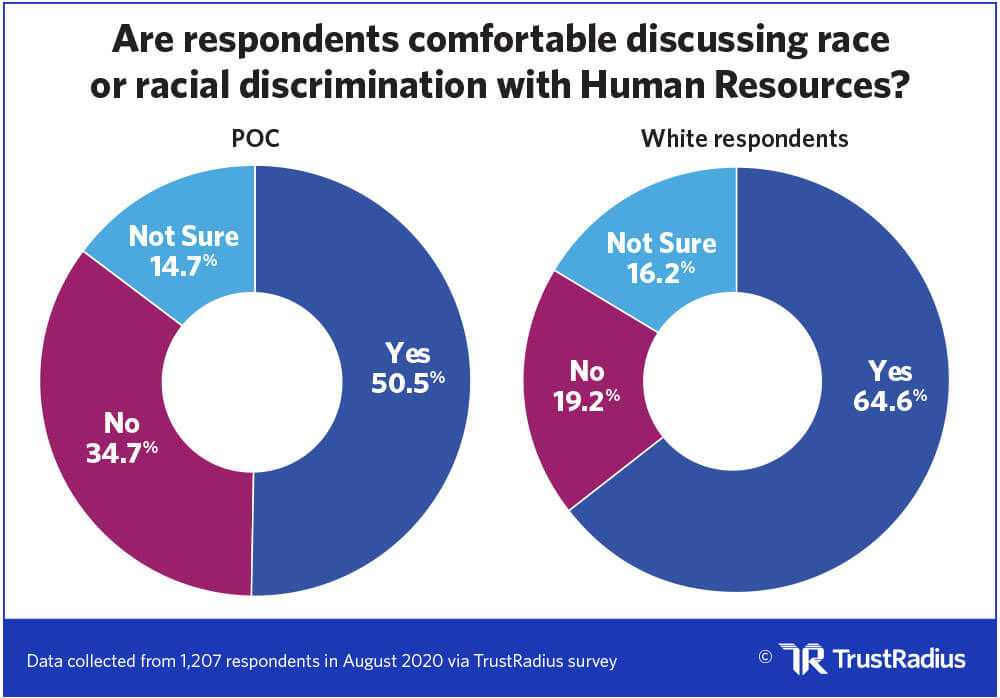
White respondents are also more likely to be satisfied with how their companies are handling racial inequality than POC, yet again indicating a disconnect between peer groups about the overall comfort-level perceived at work.
The disconnect doesn’t have to be the end of the conversation, as a majority of respondents do want companies to do more to address racial inequality and discrimination. Rather, this indicates a huge opportunity for tech companies to reach out to their POC employees, if applicable, and listen to those affected to see how they would like to be supported and affirmed in the workplace.
What POC Want Allies to Know
We asked our participants of color to share what they wish allies would know about being a person of color in the tech industry. These were their key points:
Feedback on Communication Style is a Common Form of Microaggression.
“I think Latinx people are often grouped together despite the big differences between cultures of different Latinx and Hispanic regions. We also have to combat the stereotypes and microaggressions surrounding being “fiery” or “sassy” or “too loud” which translates into us being labeled as “unprofessional” or having our opinions invalidated because of tone.”
“Black women are told they are “ok” when they need help, have issues with another employee, or even medically. Even in training and education, we have to advocate for ourselves too much so often just to get what we need and people brand that as being too vocal, too pushy, too loud.”
Stereotypes and Unconscious Bias Affect Who Gets Hired and Who Gets Promoted.
“There is the misconception that Asians are not good enough for executive positions. That being “Asian”, we excel at “doing” and not “strategizing”. But the crux of the matter is, it’s the subconscious bias that “white execs” have as to what we are capable of doing and achieving. Quiet achievers are not highly deemed as “C-level” or executive leader material. I also believe I’ve lost a few job hirings because I’m not white, pretty and blonde enough to appeal to the eye-candy of the predominantly male white execs.”
“Stereotypes are rampant. Instead of looking at the individual, hiring managers often just look at race.”
“I happen to have no accent and come across as “white passing” but know that people who come across as ethnic aren’t viewed as capable or intelligent. For latinos, I suspect there are some that wonder about immigration status and intellect. I don’t see many Hispanic or latinx in my field nor my industry.”
“A lot believe that black people have the exact same opportunity and that there is not systemic racism that is far reaching enough to affect 2nd or 3rd generation black Canadians. That is simply not true. Tokenism and a lot of ambiguous “likeability” requirements in interviews block people from being hired. The myth that there are not enough educated black people to go around is crazy, or that if we did go to university our degrees were “gifted” for affirmative action purposes.”
Progress is Uncomfortable.
“A lot of tech companies think that they are equitable by nature, and refuse to admit that their practices are discriminatory. Without this acknowledgement it is really hard to enact change. Other companies like Google, or so, that have put a lot of money into trying to fix this problem, have failed miserably, because they think DEI can be a department of the company, but refuse to enact significant change in their practices. Because of this the efforts end up being pretty pointless, but it does create a false sense of progress. We normally refer to this as performative support. Tons of BIPOC employees at tech companies don’t get promoted, so they can’t create the same level of equity and career advancement as their peers. Organizations that are actually trying to do something about it don’t get as funded or supported, because it comes with uncomfortable conversations.”
“The notion that there isn’t a race problem in tech is the biggest challenge. We have to accept that there is an issue and work towards fixing it.”
Meet Kim Carmona
Customer Success Support Analyst at TrustRadius
“After graduation, I was worried about how I was going to be seen in the tech industry. As a former journalist wanting to work with data, I knew people would question my transition.”

Entering The Tech Industry
Kim Carmona is a Customer Success Support Analyst at TrustRadius, with a Master in Information Science from The University of Texas in Austin, Texas. She worked initially in journalism, then finance for a time, noticing a budding interest in fintech. While employed at a transportation startup, she began graduate school, learning coding and data science. She made sure to secure a job in the industry after graduating.
Road to Current Role
“After graduation, I was worried about how I was going to be seen in the tech industry. As a former journalist wanting to work with data, I knew people would question my transition. Thankfully, I knew ahead of time that I would have to rebrand myself and my story.
“Tech companies need to invest in increasing POC representation. Areas of investment ought to consider focusing on low-income communities. Invest in retention plans to keep POC workers on teams or to assess why churn is happening.”
I had my brand down to the point where I was getting plenty of interviews, but I realized my time was being wasted. I was working full-time as a barista, which meant that I didn’t have unlimited time. Thankfully, my co-workers always switched shifts with me to allow me to go to interviews. Unfortunately, I dealt with a handful of no-shows or interviews where they didn’t bother to go over my portfolio or even my resume.
So when I interviewed for TrustRadius, they made me feel like they valued my time. The interview process was short, and I never got asked the same question. Most importantly, they trusted my portfolio, and gave me an assignment that wasn’t time consuming or related to their company. The fact that they valued my skills, responses, and most importantly, time, made me want to be part of this team.”
The Changes Needed
“Tech companies need to invest in increasing POC representation. Areas of investment ought to consider focusing on low-income communities. Invest in retention plans to keep POC workers on teams or to assess why churn is happening.”
“Tech companies need to invest in increasing POC representation.”
Advice to Aspiring Young Tech Professionals of Color
“Find a place that makes you feel valued. Do not let your health become subject to degradation in a workplace that does not appreciate your worth. Don’t let considerations outside of yourself like keeping up appearances hold you back, even if it is from close relationships like family. Don’t just ‘suck it up.’”
How Fast Are We Moving Forward?
Millions gathered around the world in June 2020 to protest racial inequality, sparked by protests in the U.S. addressing police brutality. Owing to this, companies across industries were urged by their consumers and clients to show their solidarity with people of color, particularly Black citizens, of the world.
In a major cultural move, several companies including Twitter and Nike expressed their support for the global African/Black diaspora by designating historic holidays such as Juneteenth as official company holidays. Many more also showed solidarity by participating in the “Black Out Tuesday” challenge which involved posting a singular black square instead of their regularly scheduled social posts. This was received with mixed emotions by the Black community, with many companies opting out. Critics of Black Out Tuesday in particular indicated that more substantial actions need to be taken to support Black people, especially Black employees, beyond what many describe as virtue signaling or performative allyship.
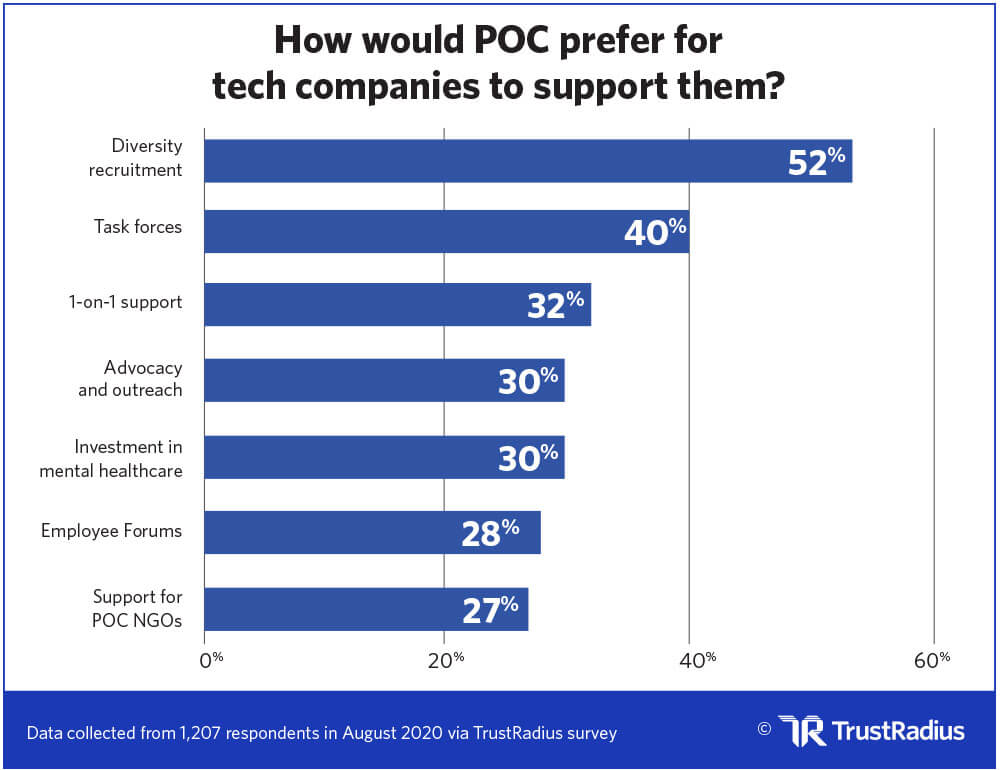
| Implementing plans to improve diversity recruitment | 52% |
| Creating task forces to identify and challenge existing biased, racist, or xenophobic behaviors in the workplace | 40% |
| Supporting POC employees one-on-one | 32% |
| External advocacy and outreach | 30% |
| Investing in time off, mental healthcare, quality of life benefits, etc. | 30% |
| Creating employee forums to discuss these issues | 28% |
| Supporting organizations with a focus on POC in giving campaigns | 27% |
People of color realize there is power in numbers, as well as long understanding the value of having a more diverse workforce. Beyond cultural improvements in the office, diversity is shown to also have a positive financial impact on business—something that might help bring more skeptical tech leaders on board to the cause.
The tech industry would do well to realize that profit doesn’t come without its people doing great work. When talent leaves or companies struggle to recruit talent, that carries a financial cost. When all the dust settles, what is a tech company without its people, its creative, driving force behind the innovation it delivers?
Meet Ezinne Udezue
Vice President of Product Management at Procore
“I realized immediately I joined the US workforce that as a Black woman interested in tech, I would need to work harder than most to get to the places I aspired in the industry.”

Entering The Tech Industry
Ezinne Udezue is Vice President of Product Management for Procore, a Principal at ProductMind, and a Founding Partner for the Kernel Fund. Now based in Austin, Ezinne got her start in the tech industry by taking an interest in Electrical Engineering as a teenager in Nigeria. She loves working in tech particularly as a product person because it allows her to lean into her curiosity about people and problems. Ezinne holds a BSc. and MSc. in Electrical Engineering from UT Arlington and Stanford University respectively, as well as a dual MBA from Columbia University and UC Berkeley.
Road to Current Role
Ezinne feels lucky to have had the career she has, with the business impact she’s had across industries and shares that it’s required a particular level of intentionality (and good fortune) to get there. “I realized immediately I joined the US workforce that as a Black woman interested in tech, I would need to work harder than most to get to the places I aspired in the industry. Earning major degrees from the top universities in the U.S. was part of gaining credibility to be selected for opportunities that would allow me to deliver irrefutable business impact along the way. I chose to join Procore because I wanted the opportunity to take my experience to an underserved industry and have a real impact in shaping the industry. The other reason was because of its culture and values: The Three O’s: Openness, Ownership, and Optimism. These happen to be my values, I am wired to work that way and wanted a place where I could show up fully with others who understood me and shared similar values.”
“It’s important that leaders are educated about and understand the value of having diverse voices at the decision making tables across the company.”
The Changes Needed
“People of color have, and in my opinion, always will need to lead others towards a more diverse and inclusive workplace. Like women in tech, we have to be unrelenting about the changes required for equity. However, tech leaders have the power to create lasting change and must step up to get true results around inclusivity and diversity. It’s important that leaders are educated about and understand the value of having diverse voices at the decision making tables across the company. Additionally, they need to gain a fundamental understanding of the productivity and performance losses, when employees aren’t able to show up fully at work because of the environment. That should clarify their fiduciary duty to drive change and ensure that each employee has the opportunity to perform at their best. I am proud of the work Procore is doing here and personally involved with intersectional groups that seek to drive inclusivity and diversity through talent management and recruitment in our tech organization.”
“Speak up even if your voice quivers.”
Advice to Aspiring Young Tech Professionals of Color
“Be ready to shine in ANY environment so you can open up opportunities for those who come after you. For those who take this on, it’s not always going to be easy and you won’t always feel supported; but speak up even if your voice quivers. I recommend finding a community: a core group of peers and mentors including those from different backgrounds than you, to create safe spaces where you all can learn, grow and be encouraged. I didn’t have the benefit of this earlier in my career, but have recently seen what communities like Women In Product and BlackPM.org can do to support technology professionals in really practical ways that I never imagined was possible.”
Exceptional Leadership in Action
Several tech leaders have risen to the occasion to show that success doesn’t have to come with a human cost. We wanted to hear from respondents about tech leaders that have impressed them over the last several months. Here’s what our respondents have witnessed during a challenging year:
Platforms for Open Discussion and Education
“Cisco did a company-wide town hall recently and invited POC to share their challenges and personal stories with the broader team to make the rest of the people more aware of the challenges others face. This I believe invites people to walk in each other’s shoes, view each other as more human and build awareness of POCs experiences. This in general is a good exercise for teams, not just for POCs.”
“Companies putting their money where their mouth is and emailing their clients to let them know they back Black Lives Matter. CEOs of companies marching and being vocal on their social media to support BLM. Companies calling out the elephant in the room and canceling company wide meetings to acknowledge how current events are affecting Black employees, and opening the floor for Black employees to talk about issues if they’d like to.”
“My current company, SurveyMonkey, has been very self aware of the issues facing BIPOC in tech. They have been very active internally and spearheading industry-wide initiatives. They are doing an excellent job of giving a voice to BIPOC employees.”
“Honeywell, even before the movement in the last few months, has had forums to promote POC joining the tech industry and growing within. It has a very strict non-discrimination policy and the CEO and other execs constantly talk about the situation and how to support POC.”
“Our Chief People Officer is a black woman. She had the courage to share her personal story on a company wide call and provided a very white audience a glimpse into the fears a black mother and wife of black man has when their loved ones leave the house. However the sharing was awkward because it was situated in between giving updates on sales numbers and a new product release. I wish this would have been a dedicated meeting to talk specifically about this, so I felt that was unfortunate and did a disservice to her personal sharing.”
Accountability, With Published Commitments
“Google has a yearly report they publish on their diversity breakdowns. They also cover reasons for the changes and their planned efforts for the year. It would be great if every company had a report like this the same way every company has to file their taxes.”
“Our executive leadership team openly talked about where the company needs to improve, and developed an actionable and measurable plan that was crowdsourced by employees. Specific minority groups and ERGs put together manifestos to hold our executives accountable to specific changes—such as hiring a BIPOC person in the next open executive role, creating workshops and trainings for managers, and working with firms that source diverse talent.”
“At my own company our senior leadership acknowledged that they needed to do more and were open to listening and learning from BIPOC, as well as taking steps to educate themselves (not relying on BIPOC to do all the labor) and making public commitments to change.”
“My own company has done a good job with reaching out to employees to ask for feedback on ways we can improve our own company’s racial equality and educating our employees on subjects related to it. We now have some solid plans in place with educational sessions coming up in the next few weeks between each team to discuss racial inequality.”
Investing in Change
“DoorDash has partnered with MLT to help in building a DEI pipeline of talent. They have been proactive in building strong ERGs and funding BLM.”
“I have seen companies create fellowship opportunities for interns who are POC and actively support diversity and inclusion initiatives with extra budget.”
“We looked for ways how we can eliminate “food deserts” by partnering with black entrepreneurs and sharing our technical know-how and experience. This was spurred as a response to the recent #BlackLivesMatter movement.”
“My present company has always advocated internally for fairness, equality, and workplace safety. Since January we’ve had different conversations around racism in the workplace. Our 2020 kick off had a “privilege” exercise that highlighted privilege and how as individuals in a company we can work to combat this. When the protests began my CEO talked about the effects and the stories that have been shared. They donated funds and shared links where other employees can. We had weekly mental health conversations, we had different facilitators to speak on it. Also senior leadership spoke with me to ideate how we can be better as a company and included me in the follow up actions.”
Not all efforts will get it right the first time around. But kudos to the tech companies, leaders, and especially people of color in tech who have stepped up to try to make a difference.
Key Takeaways From the People of Color in Tech Report
Conversations about racial inequality are tough. We would like to thank all of our survey participants for helping us highlight how different groups within the tech industry are affected by racial inequality and unconscious bias. Tech leaders especially will benefit from reading this report and sharing it with their workforces as a way to open up conversations.
In analyzing the data from our survey, we’ve recognized 10 key takeaways for everyone in tech to take to heart while moving forward towards making the industry a more equitable community for all.
- Don’t wait to take Diversity & Inclusion seriously—start acting now.
- POC still deal with racial discrimination in the office. They are twice as likely to experience racial issues at work than their white peers.
- POC and white allies are choosing diverse companies over those sticking with the status quo, so diversifying your workforce can help you attract and retain talent.
- Not only does the workforce need to diversify. Tech leadership teams need to diversify as well.
- Tech employees are more likely to support D&I initiatives than top leadership.
- BIPOC and POC are both respectful terms for referring to people of color, with the latter being the most commonly preferred choice.
- Access to networking and suitable mentors is one of the biggest challenges for POC looking to get into tech or advance their careers in the field.
- Addressing unconscious bias in hiring, recruitment, career growth, and promotions is one of the most important actions employers can take to make tech a more equitable industry.
- Cultural competency will be a key component in changing how the tech industry operates. In addition to unconscious bias training, employers should look towards initiatives that seek to educate employees.
- There are many examples of exceptional leadership and D&I initiatives that work to make tech a safer space for POC. Copy them!
For questions, comments, and press inquiries related to this research, please email pr@trustradius.com. We would love to hear your feedback.
We’ve brought the diversity and inclusion conversation to life! Join our panel of executives for an honest conversation about the lack of diversity in tech, and what you can do about it.”
Respondent Demographics
| Number of Respondents | Percent of Respondents | |
RACE/ETHNICITY |
||
| White | 571 | 44% |
| Latine | 157 | 12% |
| Black or African American | 204 | 16% |
| Asian | 212 | 16% |
| American Indian or Alaska Native | 24 | 2% |
| Some other race, ethnicity, or origin | 94 | 7% |
| Number of Respondents | Percent of Respondents | |
JOB TITLE |
||
| Entry Level | 23 | 3% |
| Associate/Analyst | 213 | 25% |
| Manager | 192 | 22% |
| Senior Manager | 109 | 13% |
| Director | 112 | 13% |
| Consultant | 72 | 8% |
| Vice President | 34 | 4% |
| C-level executive (excluding CEO) | 34 | 4% |
| CEO | 16 | 2% |
| Owner/Principal | 35 | 4% |
| Founder/Co-Founder | 23 | 3% |
| Number of Respondents | Percent of Respondents | |
DEPARTMENT |
||
| Corporate | 66 | 8% |
| Customer Service | 33 | 4% |
| Engineering | 90 | 11% |
| Finance and Accounting | 48 | 6% |
| Human Resources | 36 | 4% |
| Information Technology | 292 | 34% |
| Legal | 7 | 1% |
| Manufacturing | 9 | 1% |
| Marketing | 117 | 14% |
| Product Management | 34 | 4% |
| ProfessionalServuces | 45 | 5% |
| Quality Assurance | 4 | 0% |
| Research & Development | 22 | 3% |
| Sales | 47 | 6% |
| Social Media | 3 | 0% |
| Number of Respondents | Percent of Respondents | |
COMPANY SIZE |
||
| 1-10 employees | 92 | 10% |
| 11-50 employees | 134 | 15% |
| 51-200 employees | 178 | 19% |
| 201-500 employees | 109 | 13% |
| 501-1,000 employees | 86 | 9% |
| 1,001-5,000 employees | 109 | 12% |
| 5,001-10,000 employees | 70 | 8% |
| 10,001+ employees | 135 | 15% |
| Number of Respondents | Percent of Respondents | |
LOCATION BY MAJOR TECH CITY IN THE U.S. |
||
| Atlanta, GA | 26 | 3% |
| Austin, TX | 60 | 7% |
| Boston, MA | 25 | 3% |
| Chicago, IL | 31 | 3% |
| Dallas-Fort Worth, TX | 25 | 3% |
| Denver, CO | 21 | 2% |
| Los angeles, CA | 44 | 5% |
| New York, NY | 55 | 6% |
| San Diego, CA | 9 | 1% |
| San Francisco, CA | 55 | 6% |
| Number of Respondents | Percent of Respondents | |
LOCATION BY CONTINENT |
||
| North America | 403 | 81% |
| United States | 368 | 74% |
| Canada | 29 | 6% |
| Mexico | 4 | 1% |
| Other | 2 | 0% |
| Africa | 4 | 1% |
| Asia | 27 | 5% |
| Australia/Oceania | 10 | 2% |
| Europe | 50 | 10% |
| South America | 6 | 1% |
| Number of Respondents | Percent of Respondents | |
GENDER |
||
| Men | 551 | 46% |
| Women | 334 | 28% |
| Non-Binary | 11 | 1% |
| Did Not Disclose | 311 | 26% |














